EX-99.1
Published on July 16, 2025

Second Quarter 2025 Earnings Conference Call July 16, 2025 Exhibit 99.1
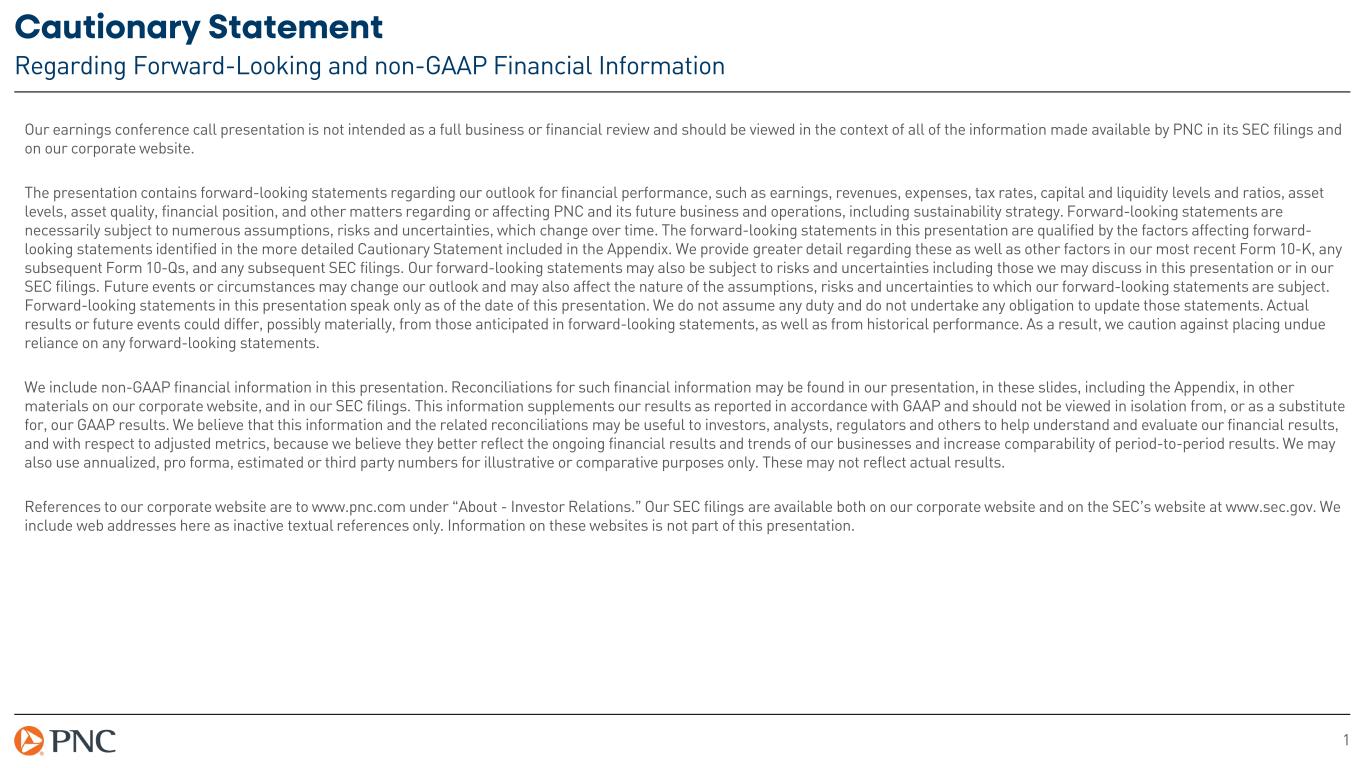
1 Cautionary Statement Regarding Forward-Looking and non-GAAP Financial Information Our earnings conference call presentation is not intended as a full business or financial review and should be viewed in the context of all of the information made available by PNC in its SEC filings and on our corporate website. The presentation contains forward-looking statements regarding our outlook for financial performance, such as earnings, revenues, expenses, tax rates, capital and liquidity levels and ratios, asset levels, asset quality, financial position, and other matters regarding or affecting PNC and its future business and operations, including sustainability strategy. Forward-looking statements are necessarily subject to numerous assumptions, risks and uncertainties, which change over time. The forward-looking statements in this presentation are qualified by the factors affecting forward- looking statements identified in the more detailed Cautionary Statement included in the Appendix. We provide greater detail regarding these as well as other factors in our most recent Form 10-K, any subsequent Form 10-Qs, and any subsequent SEC filings. Our forward-looking statements may also be subject to risks and uncertainties including those we may discuss in this presentation or in our SEC filings. Future events or circumstances may change our outlook and may also affect the nature of the assumptions, risks and uncertainties to which our forward-looking statements are subject. Forward-looking statements in this presentation speak only as of the date of this presentation. We do not assume any duty and do not undertake any obligation to update those statements. Actual results or future events could differ, possibly materially, from those anticipated in forward-looking statements, as well as from historical performance. As a result, we caution against placing undue reliance on any forward-looking statements. We include non-GAAP financial information in this presentation. Reconciliations for such financial information may be found in our presentation, in these slides, including the Appendix, in other materials on our corporate website, and in our SEC filings. This information supplements our results as reported in accordance with GAAP and should not be viewed in isolation from, or as a substitute for, our GAAP results. We believe that this information and the related reconciliations may be useful to investors, analysts, regulators and others to help understand and evaluate our financial results, and with respect to adjusted metrics, because we believe they better reflect the ongoing financial results and trends of our businesses and increase comparability of period-to-period results. We may also use annualized, pro forma, estimated or third party numbers for illustrative or comparative purposes only. These may not reflect actual results. References to our corporate website are to www.pnc.com under “About - Investor Relations.” Our SEC filings are available both on our corporate website and on the SEC’s website at www.sec.gov. We include web addresses here as inactive textual references only. Information on these websites is not part of this presentation.
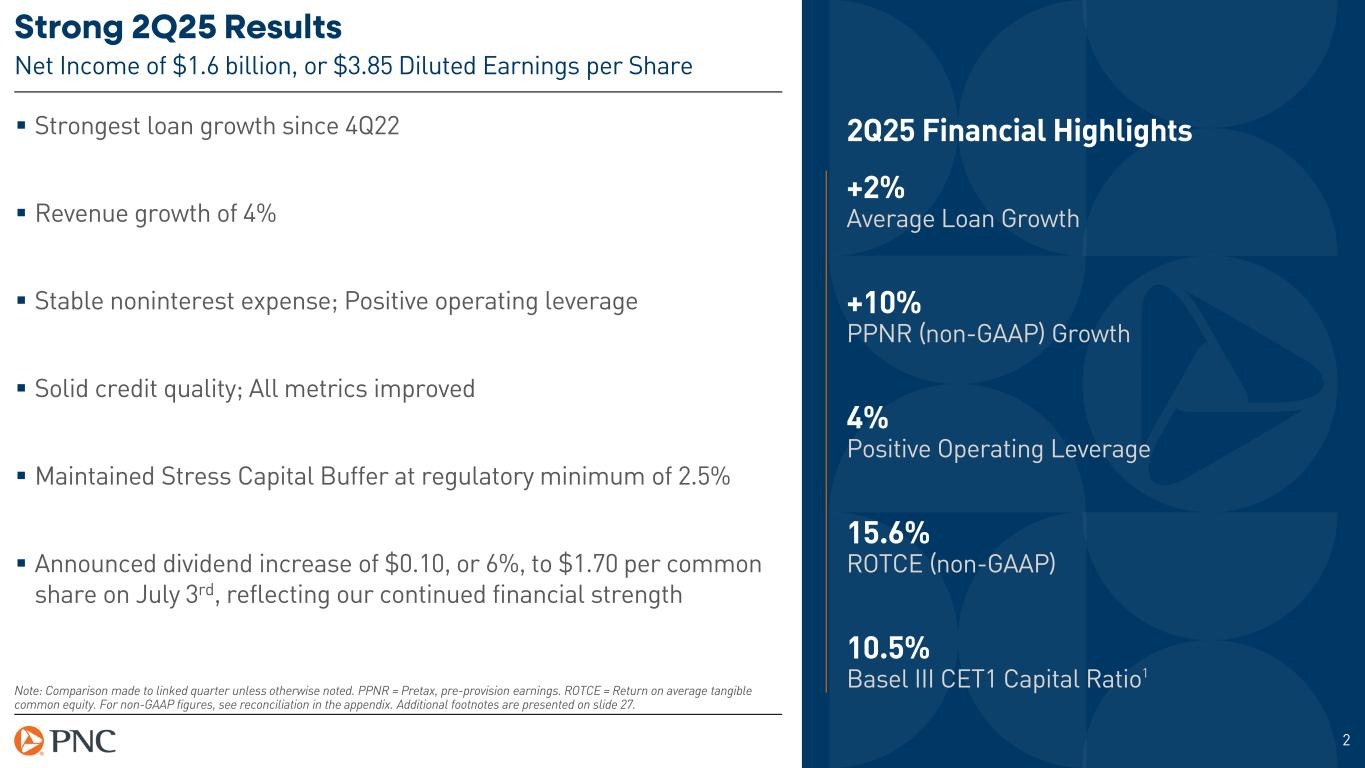
2 Strong 2Q25 Results Net Income of $1.6 billion, or $3.85 Diluted Earnings per Share Strongest loan growth since 4Q22 Revenue growth of 4% Stable noninterest expense; Positive operating leverage Solid credit quality; All metrics improved Maintained Stress Capital Buffer at regulatory minimum of 2.5% Announced dividend increase of $0.10, or 6%, to $1.70 per common share on July 3rd, reflecting our continued financial strength Note: Comparison made to linked quarter unless otherwise noted. PPNR = Pretax, pre-provision earnings. ROTCE = Return on average tangible common equity. For non-GAAP figures, see reconciliation in the appendix. Additional footnotes are presented on slide 27. +2% Average Loan Growth +10% PPNR (non-GAAP) Growth 4% Positive Operating Leverage 10.5% Basel III CET1 Capital Ratio1 2Q25 Financial Highlights 15.6% ROTCE (non-GAAP)
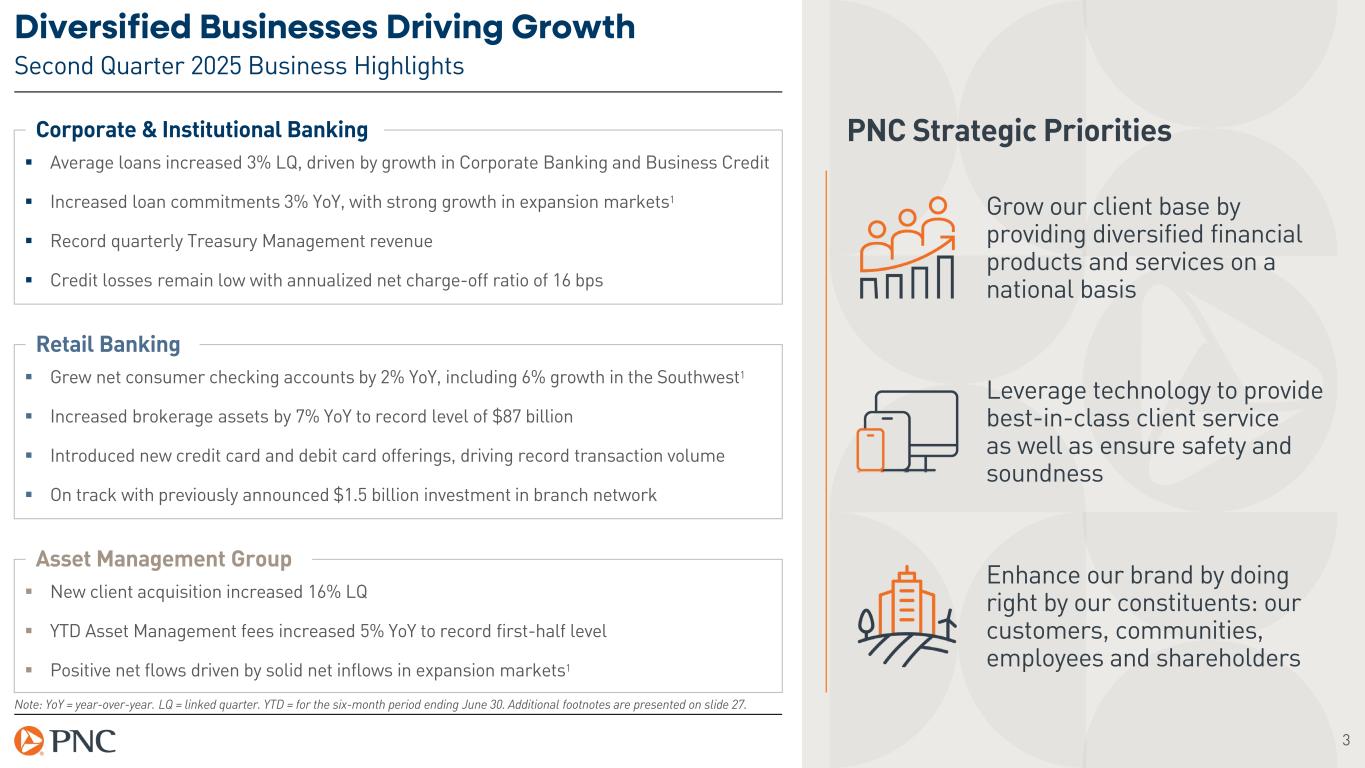
3 Diversified Businesses Driving Growth Second Quarter 2025 Business Highlights Note: YoY = year-over-year. LQ = linked quarter. YTD = for the six-month period ending June 30. Additional footnotes are presented on slide 27. Grow our client base by providing diversified financial products and services on a national basis PNC Strategic Priorities Average loans increased 3% LQ, driven by growth in Corporate Banking and Business Credit Increased loan commitments 3% YoY, with strong growth in expansion markets1 Record quarterly Treasury Management revenue Credit losses remain low with annualized net charge-off ratio of 16 bps Corporate & Institutional Banking Grew net consumer checking accounts by 2% YoY, including 6% growth in the Southwest1 Increased brokerage assets by 7% YoY to record level of $87 billion Introduced new credit card and debit card offerings, driving record transaction volume On track with previously announced $1.5 billion investment in branch network Retail Banking New client acquisition increased 16% LQ YTD Asset Management fees increased 5% YoY to record first-half level Positive net flows driven by solid net inflows in expansion markets1 Asset Management Group Leverage technology to provide best-in-class client service as well as ensure safety and soundness Enhance our brand by doing right by our constituents: our customers, communities, employees and shareholders
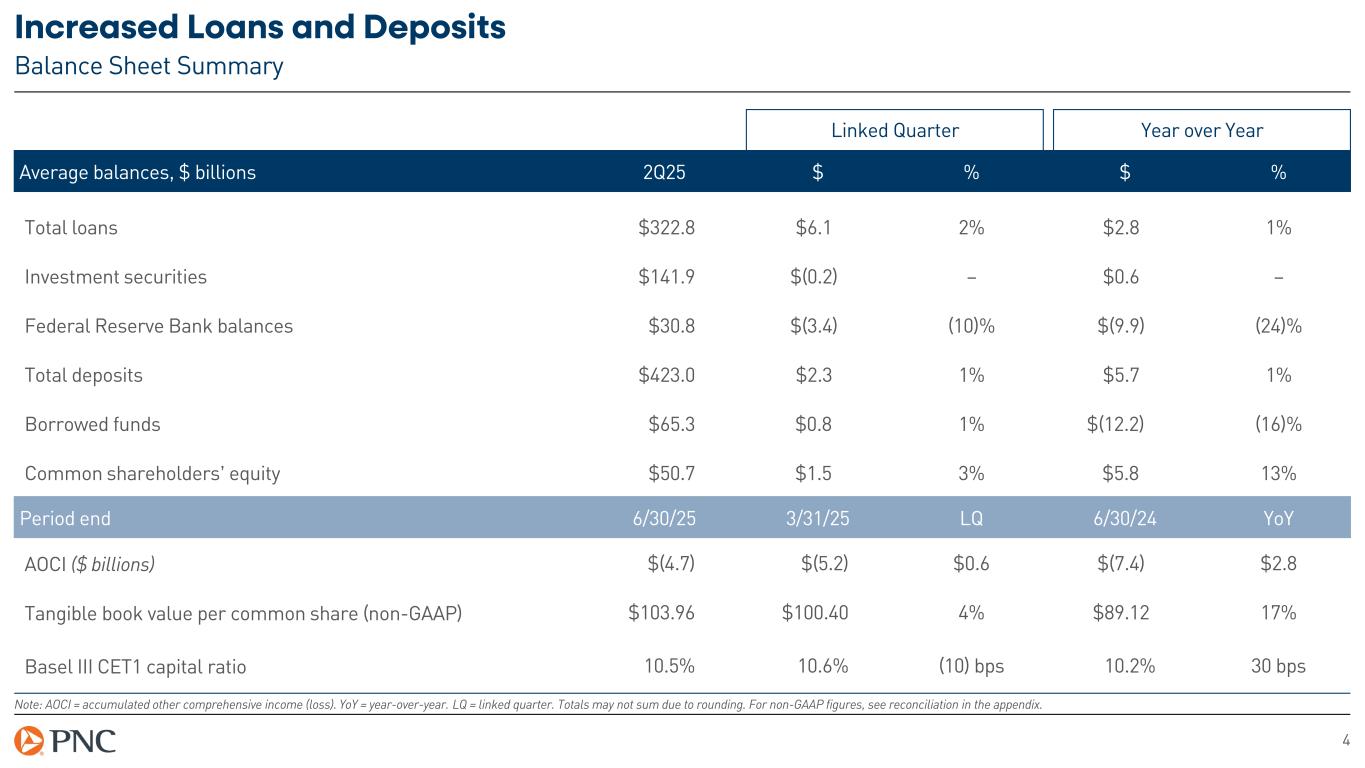
4 Increased Loans and Deposits Balance Sheet Summary Linked Quarter Year over Year Average balances, $ billions 2Q25 $ % $ % Total loans $322.8 $6.1 2% $2.8 1% Investment securities $141.9 $(0.2) – $0.6 – Federal Reserve Bank balances $30.8 $(3.4) (10)% $(9.9) (24)% Total deposits $423.0 $2.3 1% $5.7 1% Borrowed funds $65.3 $0.8 1% $(12.2) (16)% Common shareholders’ equity $50.7 $1.5 3% $5.8 13% Period end 6/30/25 3/31/25 LQ 6/30/24 YoY AOCI ($ billions) $(4.7) $(5.2) $0.6 $(7.4) $2.8 Tangible book value per common share (non-GAAP) $103.96 $100.40 4% $89.12 17% Basel III CET1 capital ratio 10.5% 10.6% (10) bps 10.2% 30 bps Note: AOCI = accumulated other comprehensive income (loss). YoY = year-over-year. LQ = linked quarter. Totals may not sum due to rounding. For non-GAAP figures, see reconciliation in the appendix.
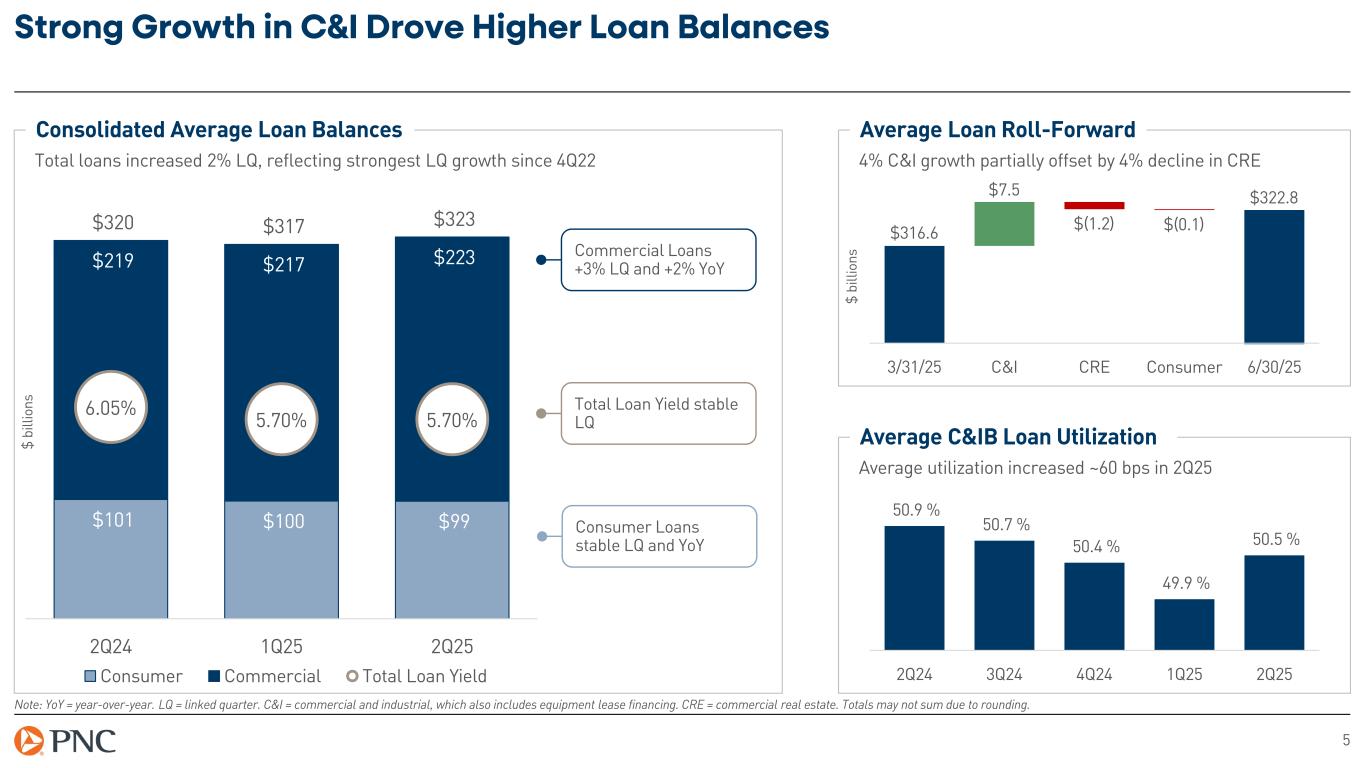
5 Strong Growth in C&I Drove Higher Loan Balances Note: YoY = year-over-year. LQ = linked quarter. C&I = commercial and industrial, which also includes equipment lease financing. CRE = commercial real estate. Totals may not sum due to rounding. Consolidated Average Loan Balances Total loans increased 2% LQ, reflecting strongest LQ growth since 4Q22 $101 $100 $99 $219 $217 $223 $320 $317 $323 6.05% 5.70% 5.70% 2Q24 1Q25 2Q25 Consumer Commercial Total Loan Yield $ bi lli on s Consumer Loans stable LQ and YoY Total Loan Yield stable LQ Commercial Loans +3% LQ and +2% YoY Average Loan Roll-Forward 4% C&I growth partially offset by 4% decline in CRE $ bi lli on s Average C&IB Loan Utilization 3/31/25 C&I CRE Consumer 6/30/25 $316.6 $7.5 $(1.2) $(0.1) $322.8 Average utilization increased ~60 bps in 2Q25 50.9 % 50.7 % 50.4 % 49.9 % 50.5 % 2Q24 3Q24 4Q24 1Q25 2Q25
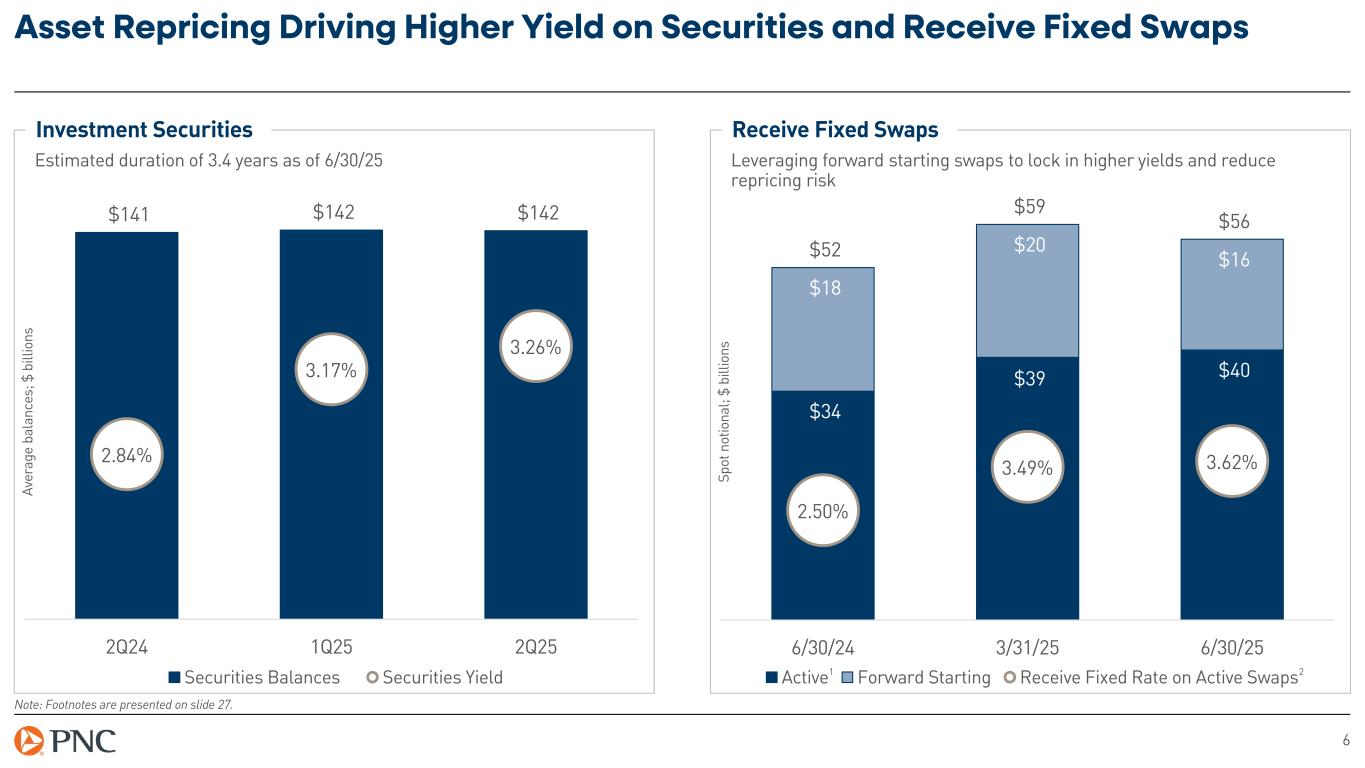
6 Asset Repricing Driving Higher Yield on Securities and Receive Fixed Swaps Note: Footnotes are presented on slide 27. Av er ag e ba la nc es ; $ b ill io ns $34 $39 $40 $18 $20 $16 $52 $59 $56 2.50% 3.49% 3.62% 6/30/24 3/31/25 6/30/25 Active Forward Starting Receive Fixed Rate on Active Swaps Sp ot n ot io na l; $ bi lli on s Investment Securities Receive Fixed Swaps Estimated duration of 3.4 years as of 6/30/25 Leveraging forward starting swaps to lock in higher yields and reduce repricing risk $141 $142 $142 2.84% 3.17% 3.26% 2Q24 1Q25 2Q25 Securities Balances Securities Yield 21
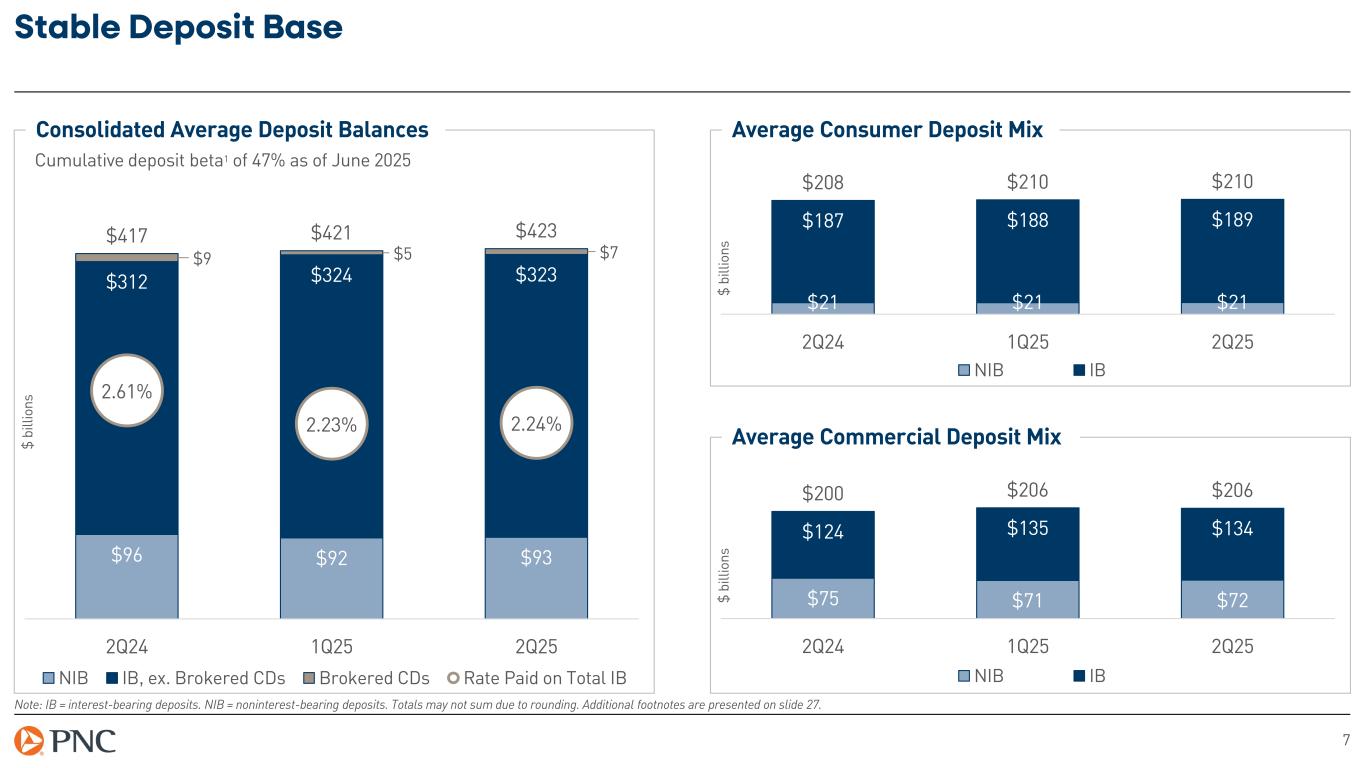
7 Stable Deposit Base Note: IB = interest-bearing deposits. NIB = noninterest-bearing deposits. Totals may not sum due to rounding. Additional footnotes are presented on slide 27. Consolidated Average Deposit Balances $96 $92 $93 $312 $324 $323 $9 $5 $7 $417 $421 $423 2.61% 2.23% 2.24% 2Q24 1Q25 2Q25 NIB IB, ex. Brokered CDs Brokered CDs Rate Paid on Total IB $ bi lli on s Cumulative deposit beta1 of 47% as of June 2025 Average Consumer Deposit Mix Average Commercial Deposit Mix $21 $21 $21 $187 $188 $189 $208 $210 $210 2Q24 1Q25 2Q25 NIB IB $75 $71 $72 $124 $135 $134 $200 $206 $206 2Q24 1Q25 2Q25 NIB IB $ bi lli on s $ bi lli on s
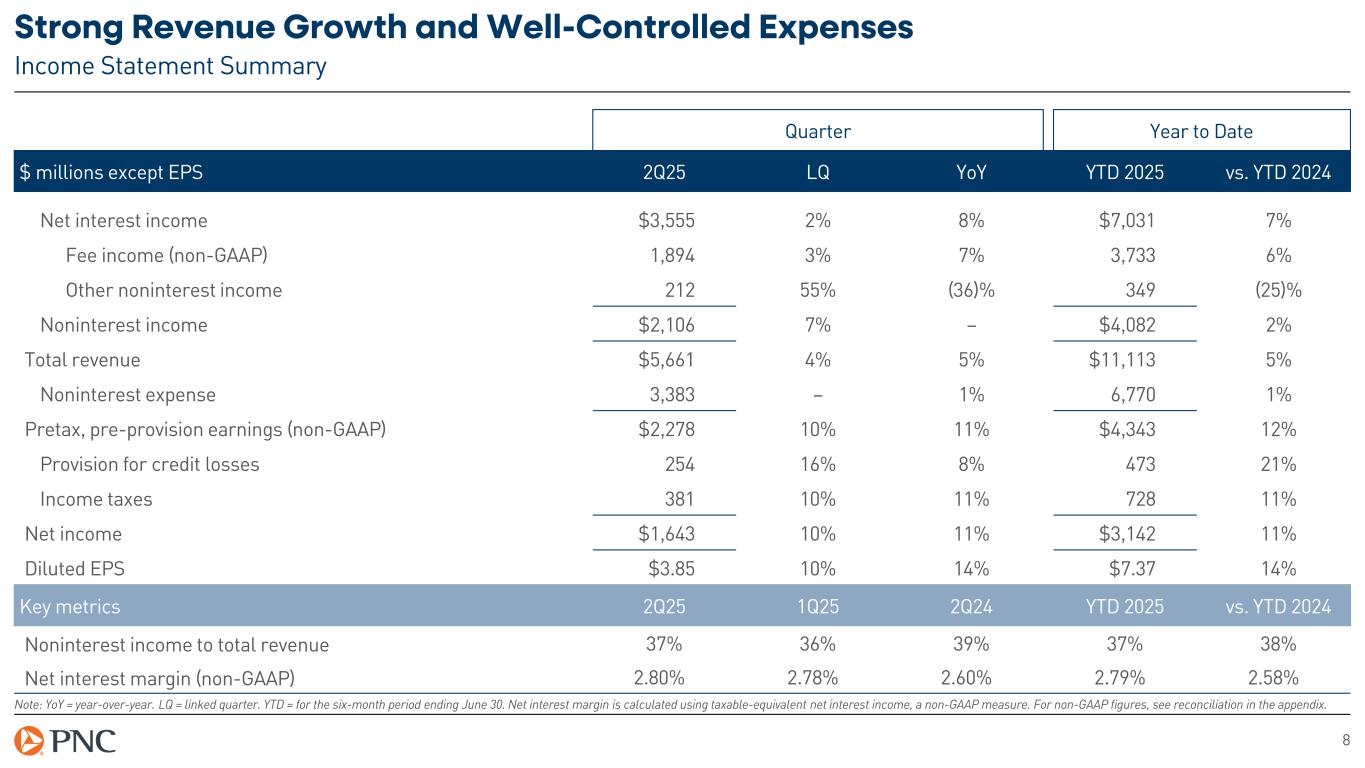
8 Strong Revenue Growth and Well-Controlled Expenses Income Statement Summary Quarter Year to Date $ millions except EPS 2Q25 LQ YoY YTD 2025 vs. YTD 2024 Net interest income $3,555 2% 8% $7,031 7% Fee income (non-GAAP) 1,894 3% 7% 3,733 6% Other noninterest income 212 55% (36)% 349 (25)% Noninterest income $2,106 7% – $4,082 2% Total revenue $5,661 4% 5% $11,113 5% Noninterest expense 3,383 – 1% 6,770 1% Pretax, pre-provision earnings (non-GAAP) $2,278 10% 11% $4,343 12% Provision for credit losses 254 16% 8% 473 21% Income taxes 381 10% 11% 728 11% Net income $1,643 10% 11% $3,142 11% Diluted EPS $3.85 10% 14% $7.37 14% Key metrics 2Q25 1Q25 2Q24 YTD 2025 vs. YTD 2024 Noninterest income to total revenue 37% 36% 39% 37% 38% Net interest margin (non-GAAP) 2.80% 2.78% 2.60% 2.79% 2.58% Note: YoY = year-over-year. LQ = linked quarter. YTD = for the six-month period ending June 30. Net interest margin is calculated using taxable-equivalent net interest income, a non-GAAP measure. For non-GAAP figures, see reconciliation in the appendix.
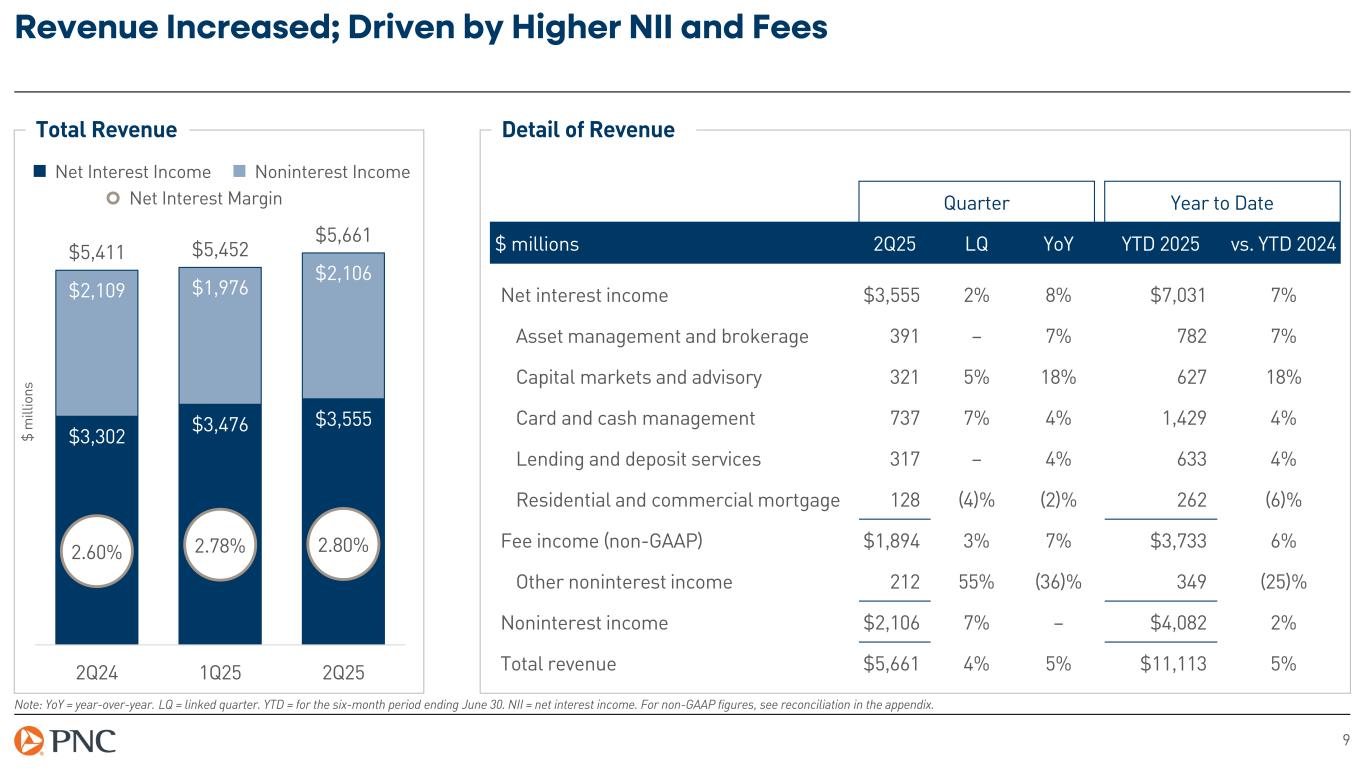
9 Revenue Increased; Driven by Higher NII and Fees Note: YoY = year-over-year. LQ = linked quarter. YTD = for the six-month period ending June 30. NII = net interest income. For non-GAAP figures, see reconciliation in the appendix. Total Revenue $3,302 $3,476 $3,555 $2,109 $1,976 $2,106 $5,411 $5,452 $5,661 2.60% 2.78% 2.80% 2Q24 1Q25 2Q25 Quarter Year to Date $ millions 2Q25 LQ YoY YTD 2025 vs. YTD 2024 Net interest income $3,555 2% 8% $7,031 7% Asset management and brokerage 391 – 7% 782 7% Capital markets and advisory 321 5% 18% 627 18% Card and cash management 737 7% 4% 1,429 4% Lending and deposit services 317 – 4% 633 4% Residential and commercial mortgage 128 (4)% (2)% 262 (6)% Fee income (non-GAAP) $1,894 3% 7% $3,733 6% Other noninterest income 212 55% (36)% 349 (25)% Noninterest income $2,106 7% – $4,082 2% Total revenue $5,661 4% 5% $11,113 5% Detail of Revenue Net Interest Income Noninterest Income Net Interest Margin $ m ill io ns
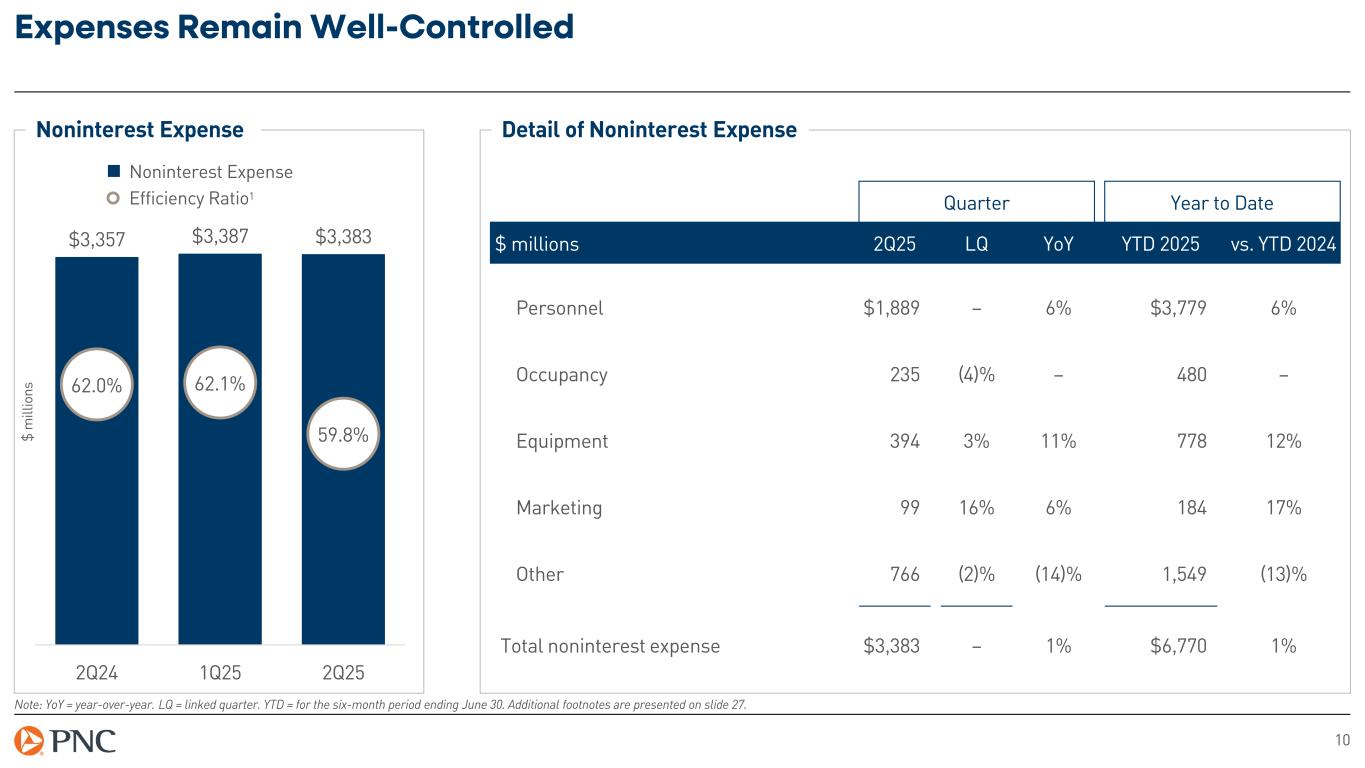
10 Expenses Remain Well-Controlled Note: YoY = year-over-year. LQ = linked quarter. YTD = for the six-month period ending June 30. Additional footnotes are presented on slide 27. Noninterest Expense $3,357 $3,387 $3,383 62.0% 62.1% 59.8% 2Q24 1Q25 2Q25 Quarter Year to Date $ millions 2Q25 LQ YoY YTD 2025 vs. YTD 2024 Personnel $1,889 – 6% $3,779 6% Occupancy 235 (4)% – 480 – Equipment 394 3% 11% 778 12% Marketing 99 16% 6% 184 17% Other 766 (2)% (14)% 1,549 (13)% Total noninterest expense $3,383 – 1% $6,770 1% Detail of Noninterest Expense $ m ill io ns Noninterest Expense Efficiency Ratio1
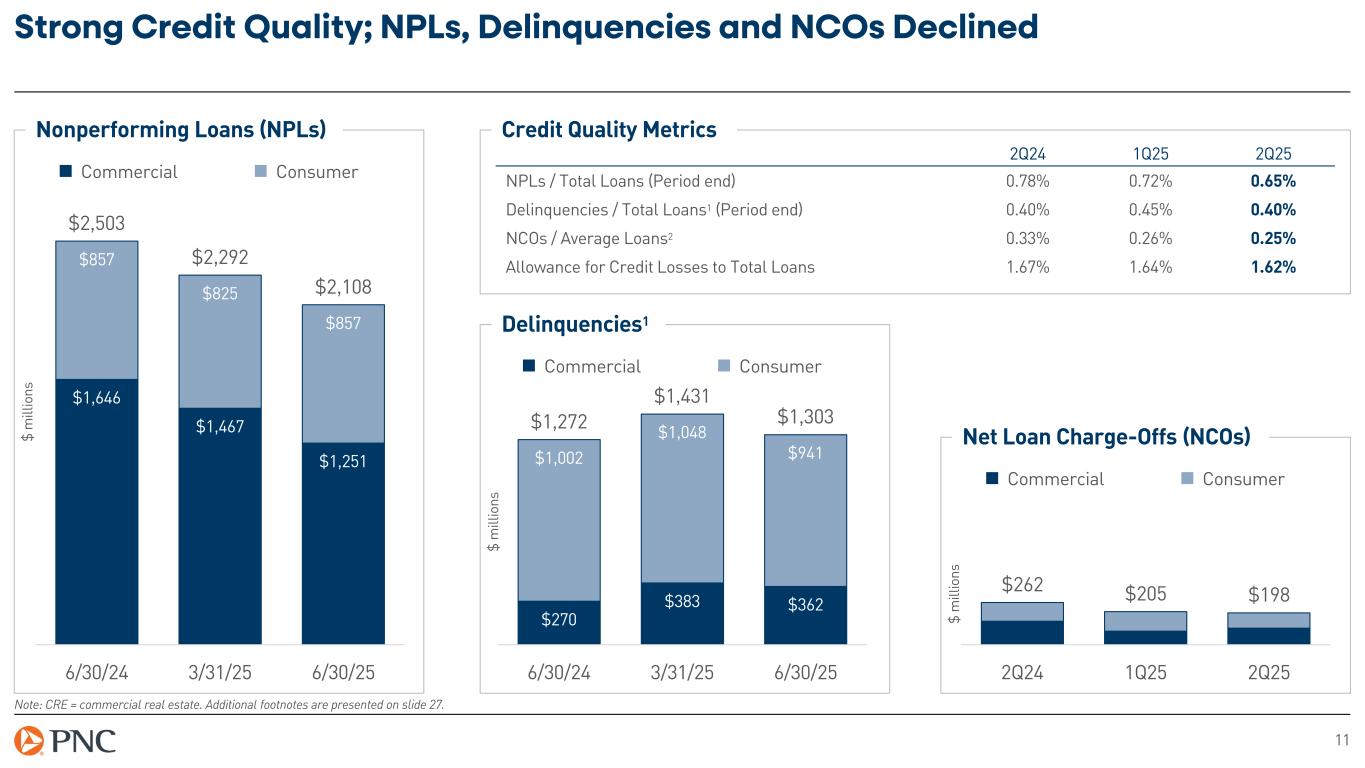
11 Strong Credit Quality; NPLs, Delinquencies and NCOs Declined Note: CRE = commercial real estate. Additional footnotes are presented on slide 27. Nonperforming Loans (NPLs) Net Loan Charge-Offs (NCOs) Credit Quality Metrics $1,646 $1,467 $1,251 $857 $825 $857 $2,503 $2,292 $2,108 6/30/24 3/31/25 6/30/25 $270 $383 $362 $1,002 $1,048 $941 $1,272 $1,431 $1,303 6/30/24 3/31/25 6/30/25 $262 $205 $198 2Q24 1Q25 2Q25 Delinquencies1 Commercial Consumer $ m ill io ns $ m ill io ns $ m ill io ns 2Q24 1Q25 2Q25 NPLs / Total Loans (Period end) 0.78% 0.72% 0.65% Delinquencies / Total Loans1 (Period end) 0.40% 0.45% 0.40% NCOs / Average Loans2 0.33% 0.26% 0.25% Allowance for Credit Losses to Total Loans 1.67% 1.64% 1.62% Commercial Consumer Commercial Consumer
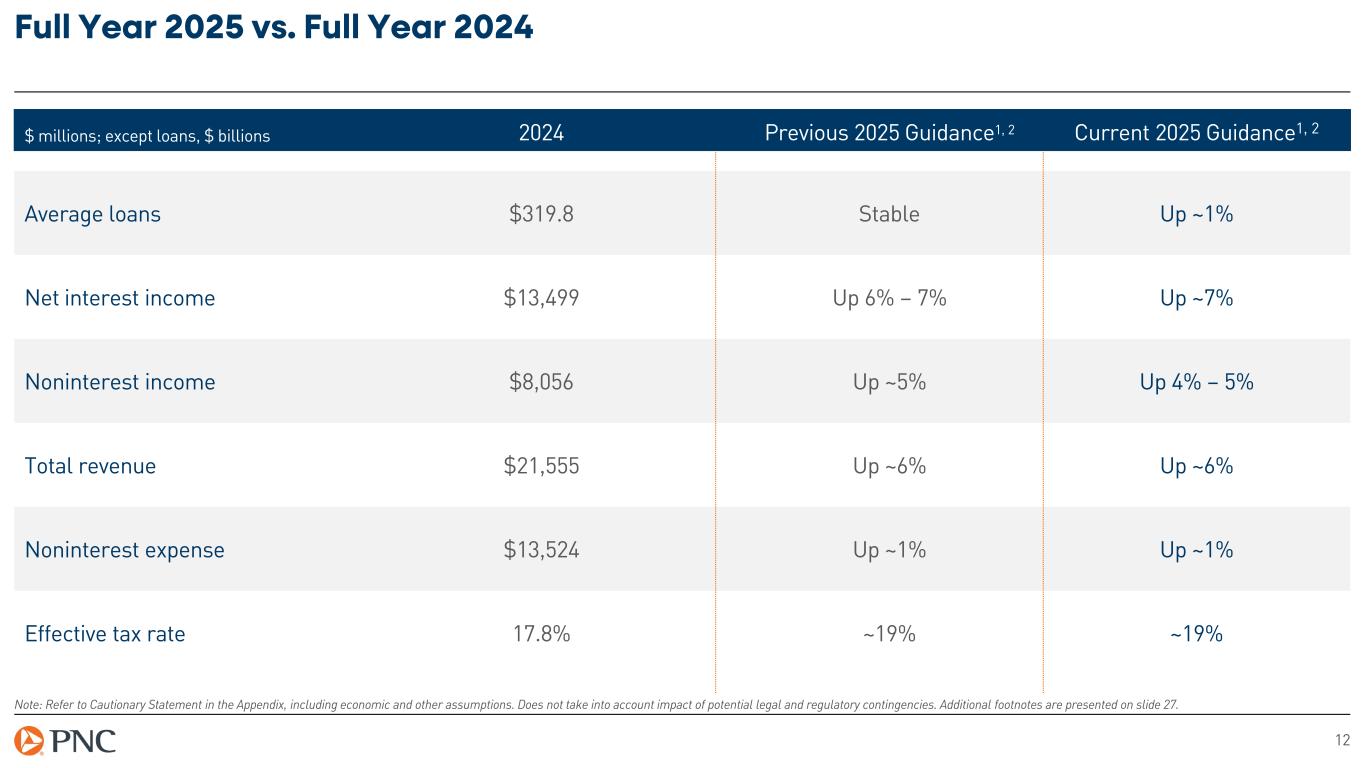
12 Full Year 2025 vs. Full Year 2024 Note: Refer to Cautionary Statement in the Appendix, including economic and other assumptions. Does not take into account impact of potential legal and regulatory contingencies. Additional footnotes are presented on slide 27. $ millions; except loans, $ billions 2024 Previous 2025 Guidance1, 2 Current 2025 Guidance1, 2 Average loans $319.8 Stable Up ~1% Net interest income $13,499 Up 6% – 7% Up ~7% Noninterest income $8,056 Up ~5% Up 4% – 5% Total revenue $21,555 Up ~6% Up ~6% Noninterest expense $13,524 Up ~1% Up ~1% Effective tax rate 17.8% ~19% ~19%
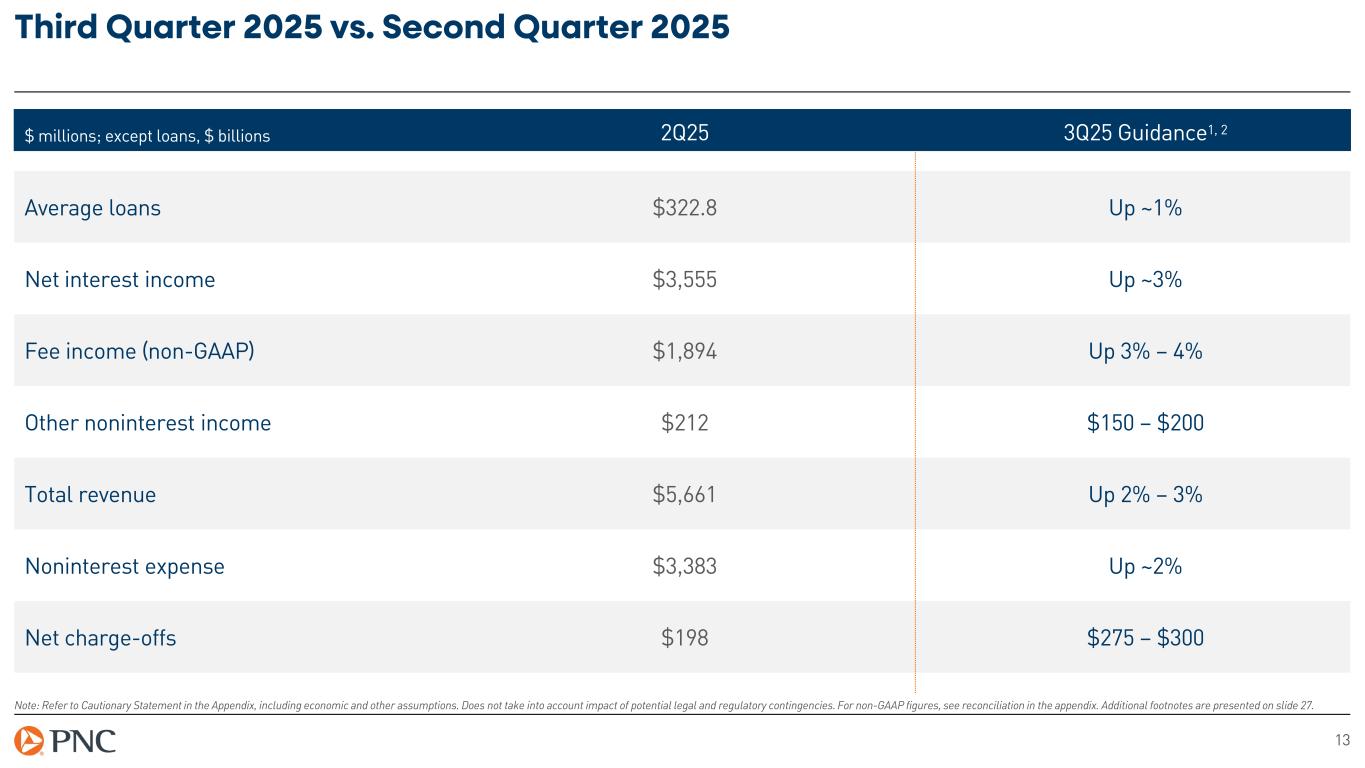
13 Third Quarter 2025 vs. Second Quarter 2025 Note: Refer to Cautionary Statement in the Appendix, including economic and other assumptions. Does not take into account impact of potential legal and regulatory contingencies. For non-GAAP figures, see reconciliation in the appendix. Additional footnotes are presented on slide 27. $ millions; except loans, $ billions 2Q25 3Q25 Guidance1, 2 Average loans $322.8 Up ~1% Net interest income $3,555 Up ~3% Fee income (non-GAAP) $1,894 Up 3% – 4% Other noninterest income $212 $150 – $200 Total revenue $5,661 Up 2% – 3% Noninterest expense $3,383 Up ~2% Net charge-offs $198 $275 – $300
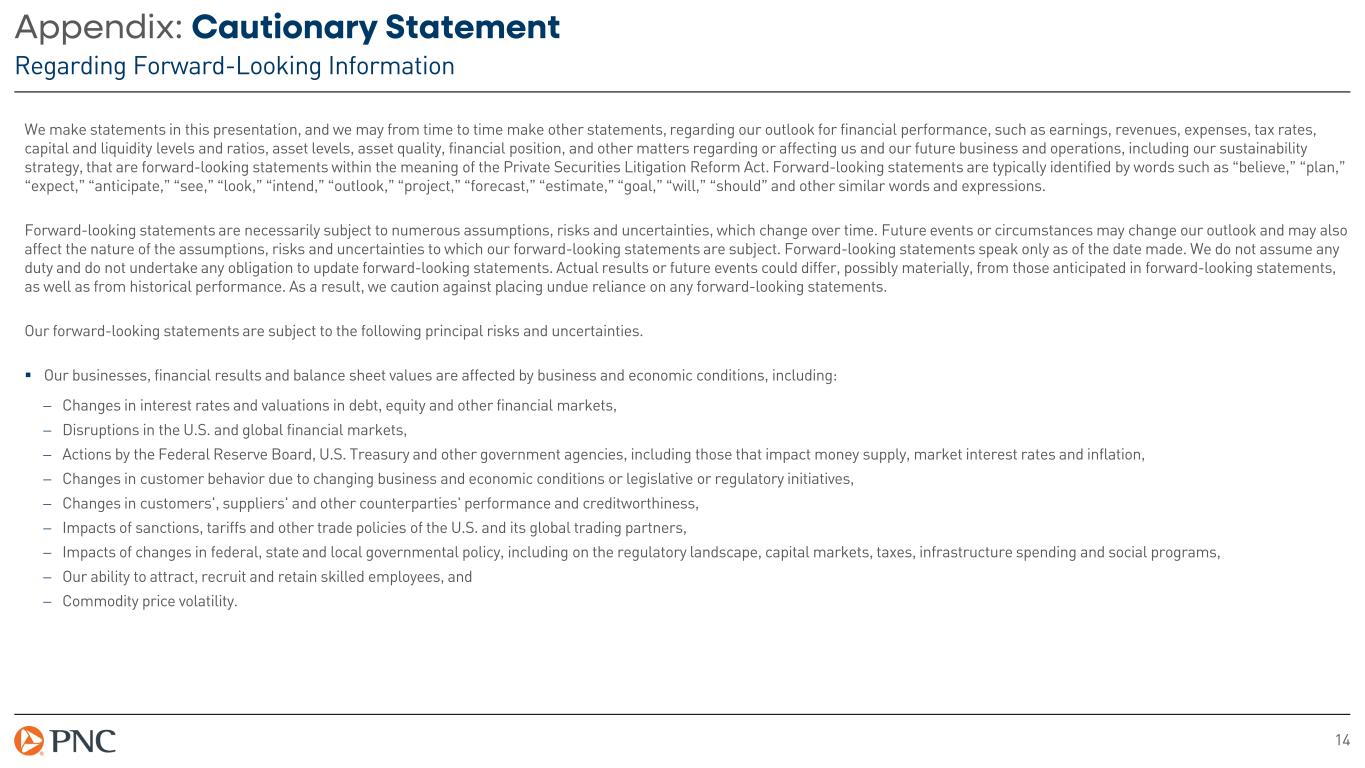
14 Appendix: Cautionary Statement Regarding Forward-Looking Information We make statements in this presentation, and we may from time to time make other statements, regarding our outlook for financial performance, such as earnings, revenues, expenses, tax rates, capital and liquidity levels and ratios, asset levels, asset quality, financial position, and other matters regarding or affecting us and our future business and operations, including our sustainability strategy, that are forward-looking statements within the meaning of the Private Securities Litigation Reform Act. Forward-looking statements are typically identified by words such as “believe,” “plan,” “expect,” “anticipate,” “see,” “look,” “intend,” “outlook,” “project,” “forecast,” “estimate,” “goal,” “will,” “should” and other similar words and expressions. Forward-looking statements are necessarily subject to numerous assumptions, risks and uncertainties, which change over time. Future events or circumstances may change our outlook and may also affect the nature of the assumptions, risks and uncertainties to which our forward-looking statements are subject. Forward-looking statements speak only as of the date made. We do not assume any duty and do not undertake any obligation to update forward-looking statements. Actual results or future events could differ, possibly materially, from those anticipated in forward-looking statements, as well as from historical performance. As a result, we caution against placing undue reliance on any forward-looking statements. Our forward-looking statements are subject to the following principal risks and uncertainties. Our businesses, financial results and balance sheet values are affected by business and economic conditions, including: − Changes in interest rates and valuations in debt, equity and other financial markets, − Disruptions in the U.S. and global financial markets, − Actions by the Federal Reserve Board, U.S. Treasury and other government agencies, including those that impact money supply, market interest rates and inflation, − Changes in customer behavior due to changing business and economic conditions or legislative or regulatory initiatives, − Changes in customers', suppliers' and other counterparties' performance and creditworthiness, − Impacts of sanctions, tariffs and other trade policies of the U.S. and its global trading partners, − Impacts of changes in federal, state and local governmental policy, including on the regulatory landscape, capital markets, taxes, infrastructure spending and social programs, − Our ability to attract, recruit and retain skilled employees, and − Commodity price volatility.
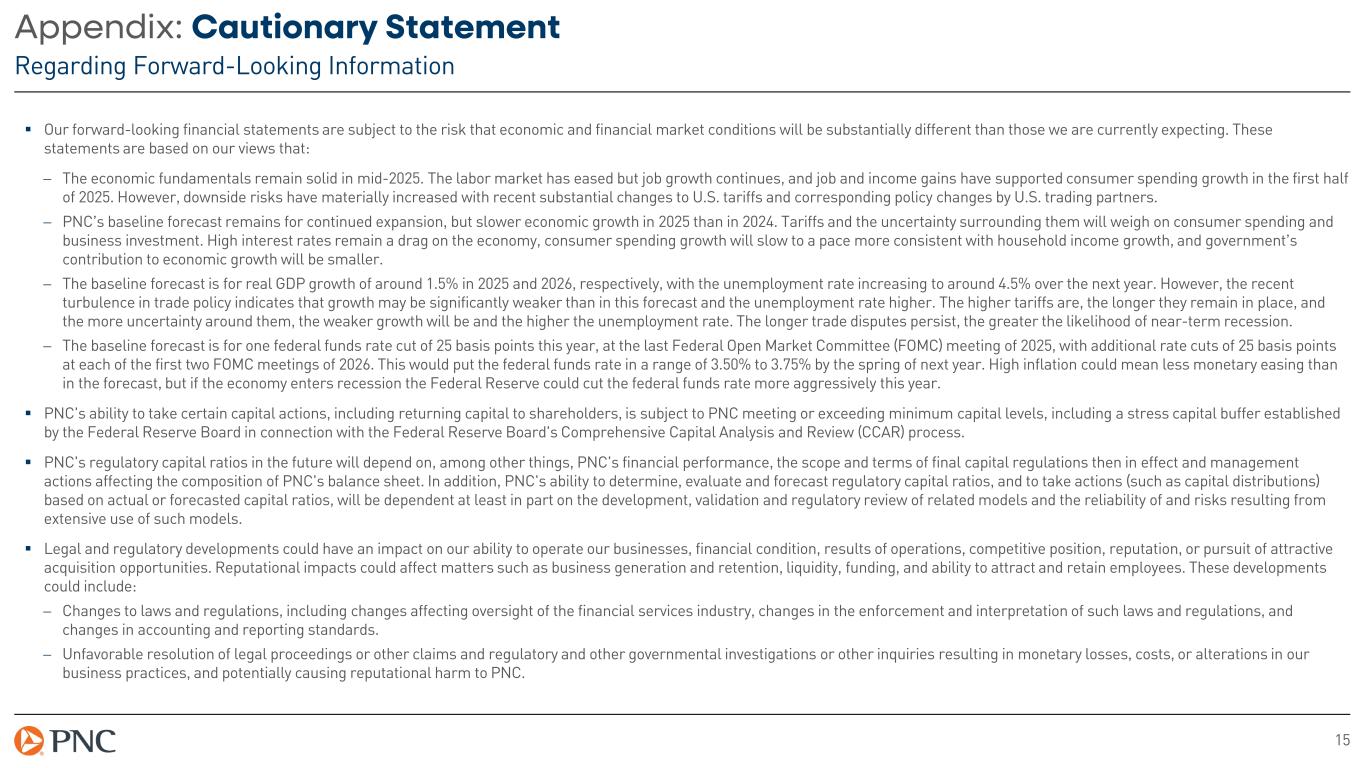
15 Appendix: Cautionary Statement Regarding Forward-Looking Information Our forward-looking financial statements are subject to the risk that economic and financial market conditions will be substantially different than those we are currently expecting. These statements are based on our views that: − The economic fundamentals remain solid in mid-2025. The labor market has eased but job growth continues, and job and income gains have supported consumer spending growth in the first half of 2025. However, downside risks have materially increased with recent substantial changes to U.S. tariffs and corresponding policy changes by U.S. trading partners. − PNC’s baseline forecast remains for continued expansion, but slower economic growth in 2025 than in 2024. Tariffs and the uncertainty surrounding them will weigh on consumer spending and business investment. High interest rates remain a drag on the economy, consumer spending growth will slow to a pace more consistent with household income growth, and government’s contribution to economic growth will be smaller. − The baseline forecast is for real GDP growth of around 1.5% in 2025 and 2026, respectively, with the unemployment rate increasing to around 4.5% over the next year. However, the recent turbulence in trade policy indicates that growth may be significantly weaker than in this forecast and the unemployment rate higher. The higher tariffs are, the longer they remain in place, and the more uncertainty around them, the weaker growth will be and the higher the unemployment rate. The longer trade disputes persist, the greater the likelihood of near-term recession. − The baseline forecast is for one federal funds rate cut of 25 basis points this year, at the last Federal Open Market Committee (FOMC) meeting of 2025, with additional rate cuts of 25 basis points at each of the first two FOMC meetings of 2026. This would put the federal funds rate in a range of 3.50% to 3.75% by the spring of next year. High inflation could mean less monetary easing than in the forecast, but if the economy enters recession the Federal Reserve could cut the federal funds rate more aggressively this year. PNC's ability to take certain capital actions, including returning capital to shareholders, is subject to PNC meeting or exceeding minimum capital levels, including a stress capital buffer established by the Federal Reserve Board in connection with the Federal Reserve Board's Comprehensive Capital Analysis and Review (CCAR) process. PNC's regulatory capital ratios in the future will depend on, among other things, PNC's financial performance, the scope and terms of final capital regulations then in effect and management actions affecting the composition of PNC's balance sheet. In addition, PNC's ability to determine, evaluate and forecast regulatory capital ratios, and to take actions (such as capital distributions) based on actual or forecasted capital ratios, will be dependent at least in part on the development, validation and regulatory review of related models and the reliability of and risks resulting from extensive use of such models. Legal and regulatory developments could have an impact on our ability to operate our businesses, financial condition, results of operations, competitive position, reputation, or pursuit of attractive acquisition opportunities. Reputational impacts could affect matters such as business generation and retention, liquidity, funding, and ability to attract and retain employees. These developments could include: − Changes to laws and regulations, including changes affecting oversight of the financial services industry, changes in the enforcement and interpretation of such laws and regulations, and changes in accounting and reporting standards. − Unfavorable resolution of legal proceedings or other claims and regulatory and other governmental investigations or other inquiries resulting in monetary losses, costs, or alterations in our business practices, and potentially causing reputational harm to PNC.
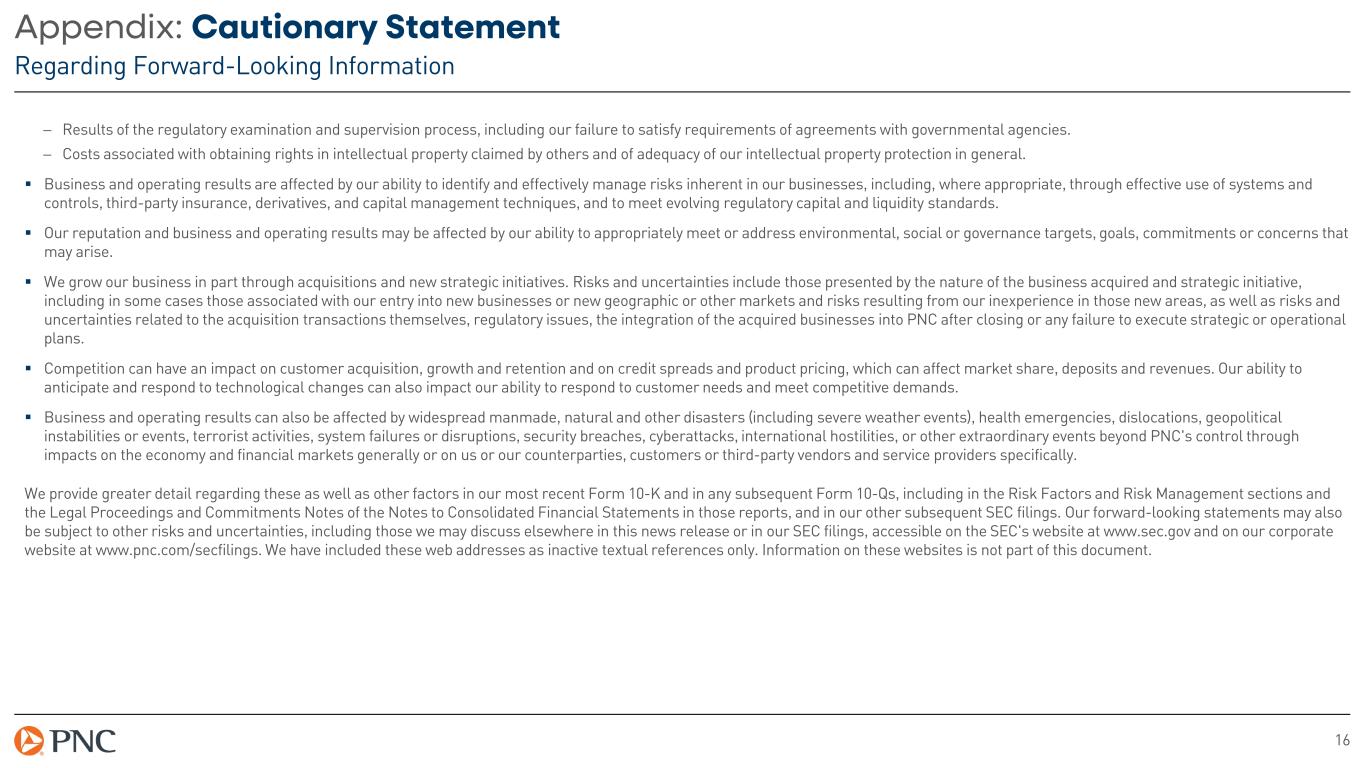
16 Appendix: Cautionary Statement Regarding Forward-Looking Information − Results of the regulatory examination and supervision process, including our failure to satisfy requirements of agreements with governmental agencies. − Costs associated with obtaining rights in intellectual property claimed by others and of adequacy of our intellectual property protection in general. Business and operating results are affected by our ability to identify and effectively manage risks inherent in our businesses, including, where appropriate, through effective use of systems and controls, third-party insurance, derivatives, and capital management techniques, and to meet evolving regulatory capital and liquidity standards. Our reputation and business and operating results may be affected by our ability to appropriately meet or address environmental, social or governance targets, goals, commitments or concerns that may arise. We grow our business in part through acquisitions and new strategic initiatives. Risks and uncertainties include those presented by the nature of the business acquired and strategic initiative, including in some cases those associated with our entry into new businesses or new geographic or other markets and risks resulting from our inexperience in those new areas, as well as risks and uncertainties related to the acquisition transactions themselves, regulatory issues, the integration of the acquired businesses into PNC after closing or any failure to execute strategic or operational plans. Competition can have an impact on customer acquisition, growth and retention and on credit spreads and product pricing, which can affect market share, deposits and revenues. Our ability to anticipate and respond to technological changes can also impact our ability to respond to customer needs and meet competitive demands. Business and operating results can also be affected by widespread manmade, natural and other disasters (including severe weather events), health emergencies, dislocations, geopolitical instabilities or events, terrorist activities, system failures or disruptions, security breaches, cyberattacks, international hostilities, or other extraordinary events beyond PNC's control through impacts on the economy and financial markets generally or on us or our counterparties, customers or third-party vendors and service providers specifically. We provide greater detail regarding these as well as other factors in our most recent Form 10-K and in any subsequent Form 10-Qs, including in the Risk Factors and Risk Management sections and the Legal Proceedings and Commitments Notes of the Notes to Consolidated Financial Statements in those reports, and in our other subsequent SEC filings. Our forward-looking statements may also be subject to other risks and uncertainties, including those we may discuss elsewhere in this news release or in our SEC filings, accessible on the SEC's website at www.sec.gov and on our corporate website at www.pnc.com/secfilings. We have included these web addresses as inactive textual references only. Information on these websites is not part of this document.
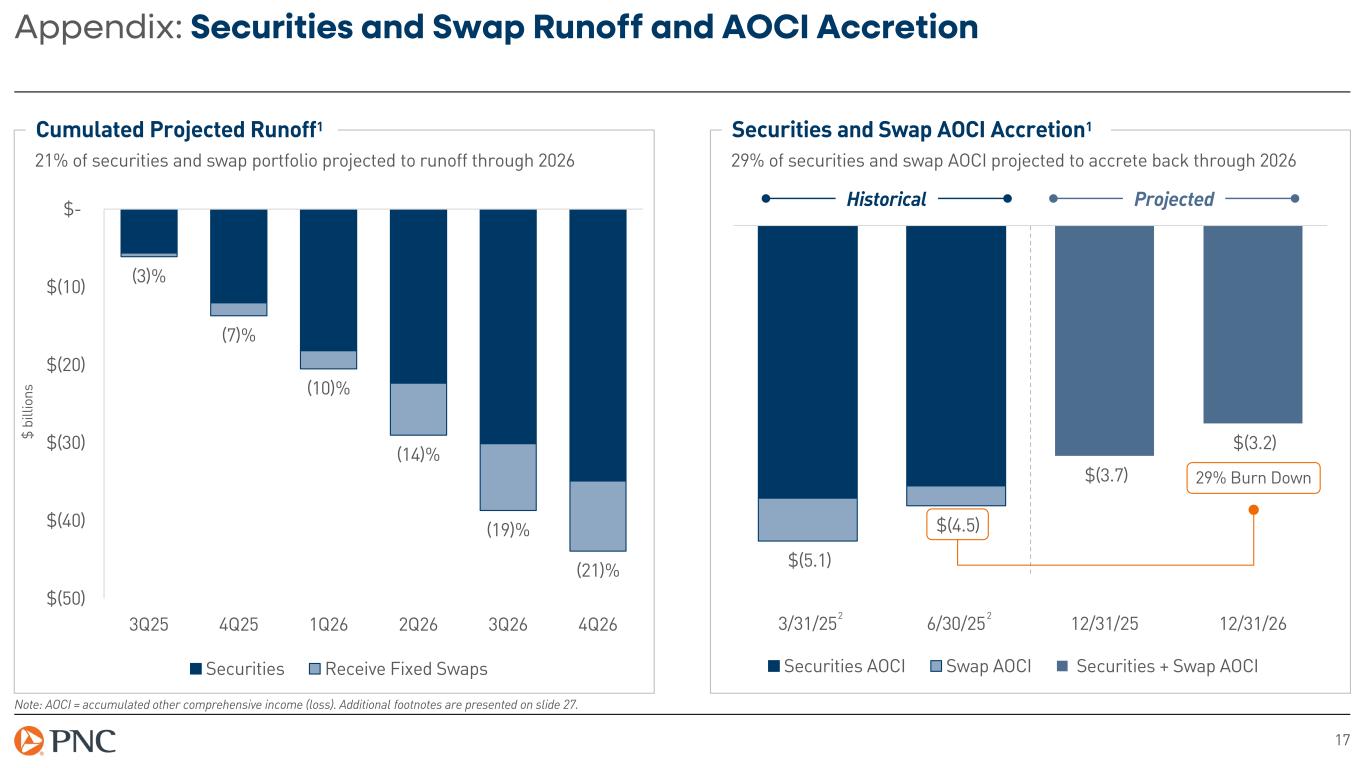
17 Appendix: Securities and Swap Runoff and AOCI Accretion Note: AOCI = accumulated other comprehensive income (loss). Additional footnotes are presented on slide 27. Cumulated Projected Runoff1 Securities and Swap AOCI Accretion1 21% of securities and swap portfolio projected to runoff through 2026 29% of securities and swap AOCI projected to accrete back through 2026 (3)% (7)% (10)% (14)% (19)% (21)% $(50) $(40) $(30) $(20) $(10) $- 3Q25 4Q25 1Q26 2Q26 3Q26 4Q26 Securities Receive Fixed Swaps $ bi lli on s $(5.1) $(4.5) $(3.7) $(3.2) 3/31/25 6/30/25 12/31/25 12/31/26 Securities AOCI Swap AOCI Securities + Swap AOCI ProjectedHistorical 29% Burn Down 2 2
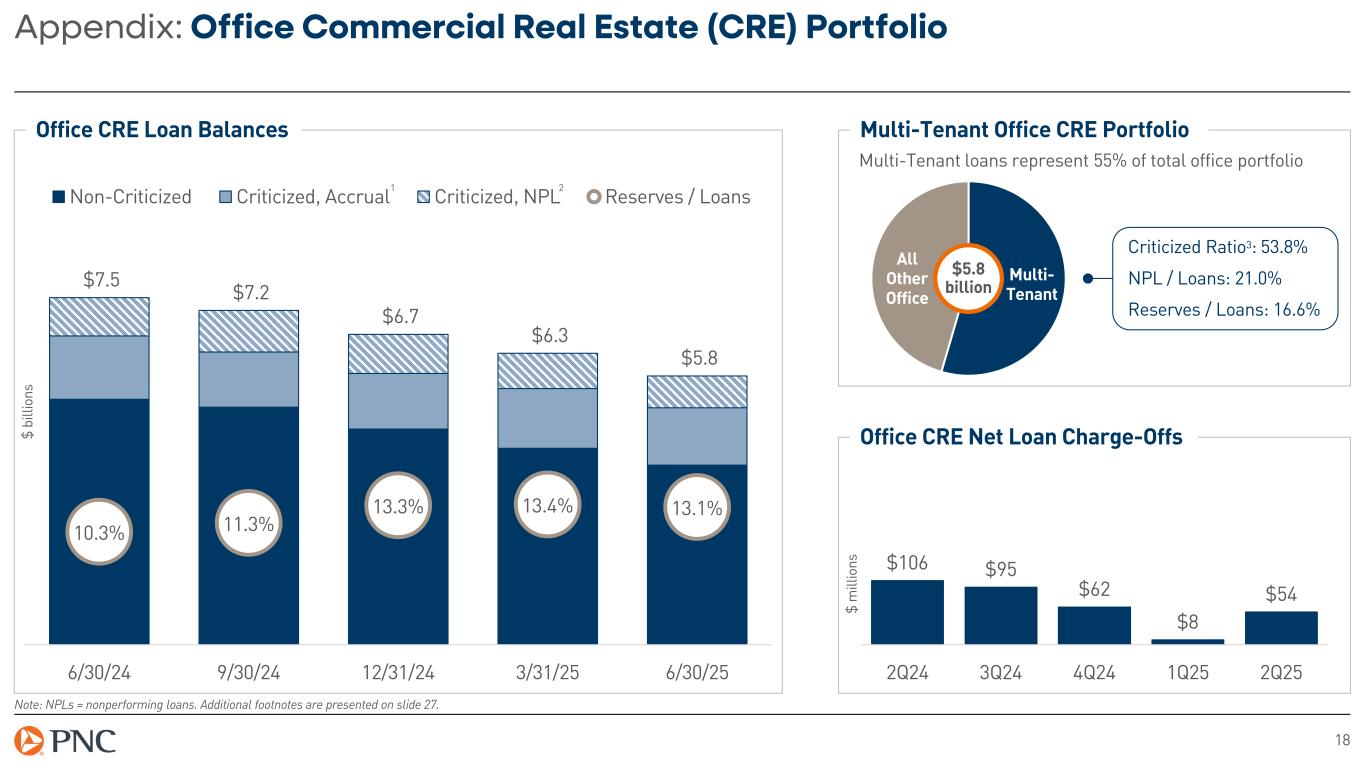
$106 $95 $62 $8 $54 2Q24 3Q24 4Q24 1Q25 2Q25 18 Appendix: Office Commercial Real Estate (CRE) Portfolio Note: NPLs = nonperforming loans. Additional footnotes are presented on slide 27. Office CRE Loan Balances Multi-Tenant Office CRE Portfolio Multi-Tenant loans represent 55% of total office portfolio Office CRE Net Loan Charge-Offs $ m ill io ns Multi- Tenant All Other Office Criticized Ratio3: 53.8% NPL / Loans: 21.0% Reserves / Loans: 16.6% $5.8 billion$7.5 $7.2 $6.7 $6.3 $5.8 10.3% 11.3% 13.3% 13.4% 13.1% 6/30/24 9/30/24 12/31/24 3/31/25 6/30/25 Non-Criticized Criticized, Accrual Criticized, NPL Reserves / Loans $ bi lli on s 1 2
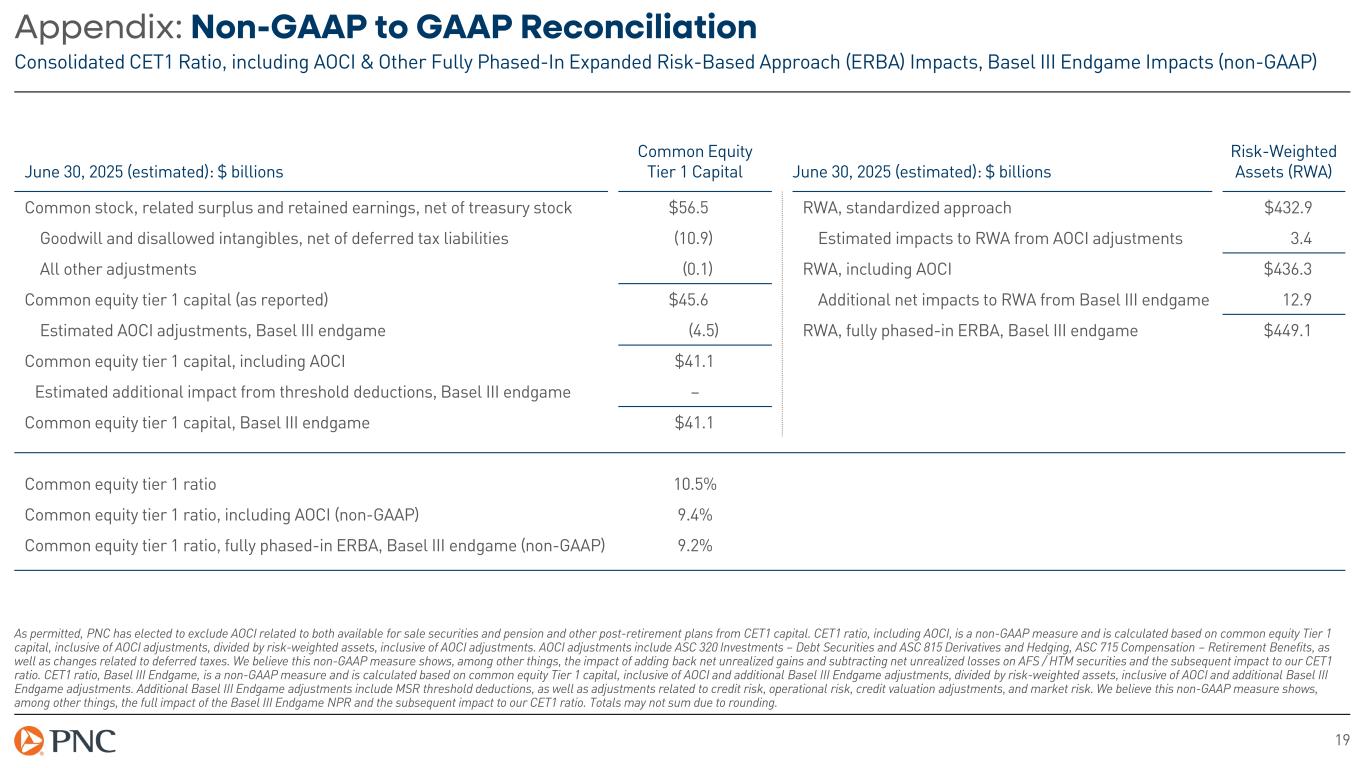
19 Appendix: Non-GAAP to GAAP Reconciliation Consolidated CET1 Ratio, including AOCI & Other Fully Phased-In Expanded Risk-Based Approach (ERBA) Impacts, Basel III Endgame Impacts (non-GAAP) As permitted, PNC has elected to exclude AOCI related to both available for sale securities and pension and other post-retirement plans from CET1 capital. CET1 ratio, including AOCI, is a non-GAAP measure and is calculated based on common equity Tier 1 capital, inclusive of AOCI adjustments, divided by risk-weighted assets, inclusive of AOCI adjustments. AOCI adjustments include ASC 320 Investments – Debt Securities and ASC 815 Derivatives and Hedging, ASC 715 Compensation – Retirement Benefits, as well as changes related to deferred taxes. We believe this non-GAAP measure shows, among other things, the impact of adding back net unrealized gains and subtracting net unrealized losses on AFS / HTM securities and the subsequent impact to our CET1 ratio. CET1 ratio, Basel III Endgame, is a non-GAAP measure and is calculated based on common equity Tier 1 capital, inclusive of AOCI and additional Basel III Endgame adjustments, divided by risk-weighted assets, inclusive of AOCI and additional Basel III Endgame adjustments. Additional Basel III Endgame adjustments include MSR threshold deductions, as well as adjustments related to credit risk, operational risk, credit valuation adjustments, and market risk. We believe this non-GAAP measure shows, among other things, the full impact of the Basel III Endgame NPR and the subsequent impact to our CET1 ratio. Totals may not sum due to rounding. June 30, 2025 (estimated): $ billions Common Equity Tier 1 Capital June 30, 2025 (estimated): $ billions Risk-Weighted Assets (RWA) Common stock, related surplus and retained earnings, net of treasury stock $56.5 RWA, standardized approach $432.9 Goodwill and disallowed intangibles, net of deferred tax liabilities (10.9) Estimated impacts to RWA from AOCI adjustments 3.4 All other adjustments (0.1) RWA, including AOCI $436.3 Common equity tier 1 capital (as reported) $45.6 Additional net impacts to RWA from Basel III endgame 12.9 Estimated AOCI adjustments, Basel III endgame (4.5) RWA, fully phased-in ERBA, Basel III endgame $449.1 Common equity tier 1 capital, including AOCI $41.1 Estimated additional impact from threshold deductions, Basel III endgame – Common equity tier 1 capital, Basel III endgame $41.1 Common equity tier 1 ratio 10.5% Common equity tier 1 ratio, including AOCI (non-GAAP) 9.4% Common equity tier 1 ratio, fully phased-in ERBA, Basel III endgame (non-GAAP) 9.2%
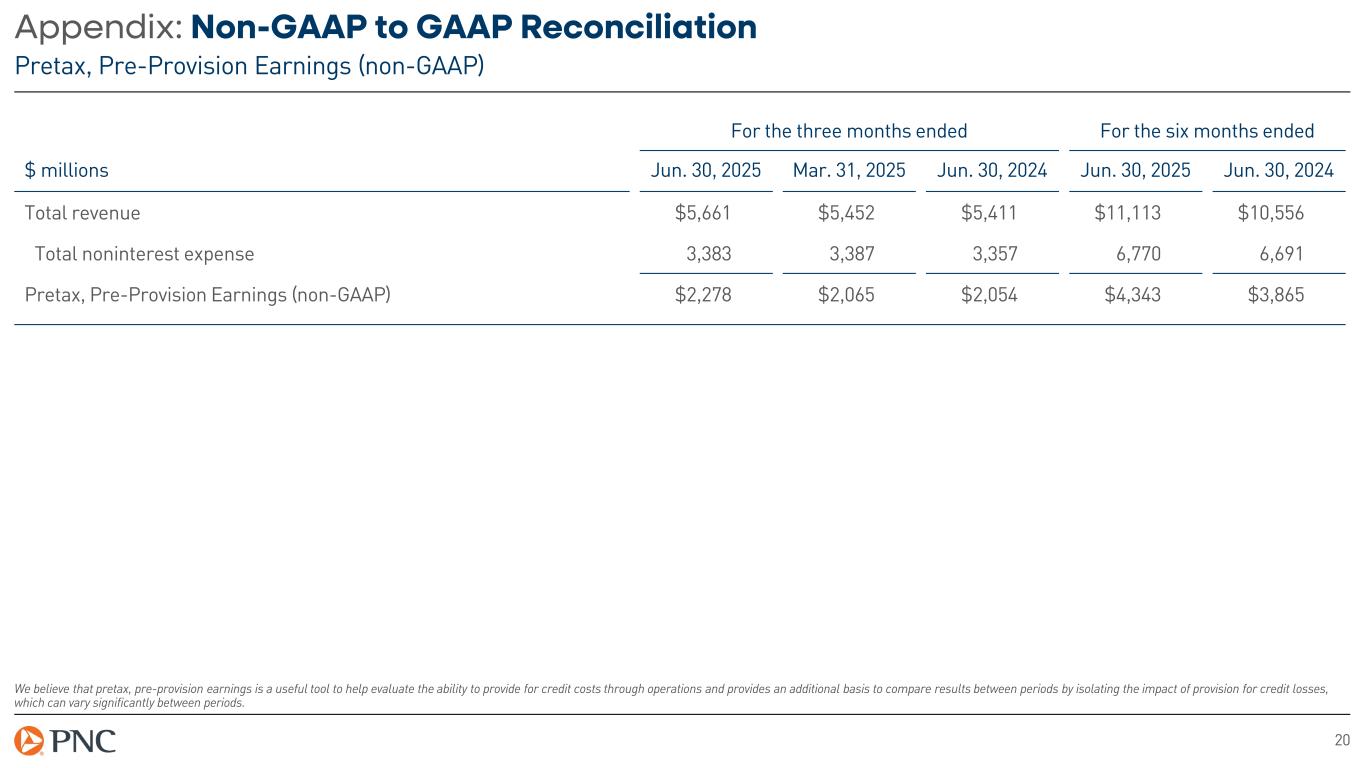
20 Appendix: Non-GAAP to GAAP Reconciliation Pretax, Pre-Provision Earnings (non-GAAP) For the three months ended For the six months ended $ millions Jun. 30, 2025 Mar. 31, 2025 Jun. 30, 2024 Jun. 30, 2025 Jun. 30, 2024 Total revenue $5,661 $5,452 $5,411 $11,113 $10,556 Total noninterest expense 3,383 3,387 3,357 6,770 6,691 Pretax, Pre-Provision Earnings (non-GAAP) $2,278 $2,065 $2,054 $4,343 $3,865 We believe that pretax, pre-provision earnings is a useful tool to help evaluate the ability to provide for credit costs through operations and provides an additional basis to compare results between periods by isolating the impact of provision for credit losses, which can vary significantly between periods.
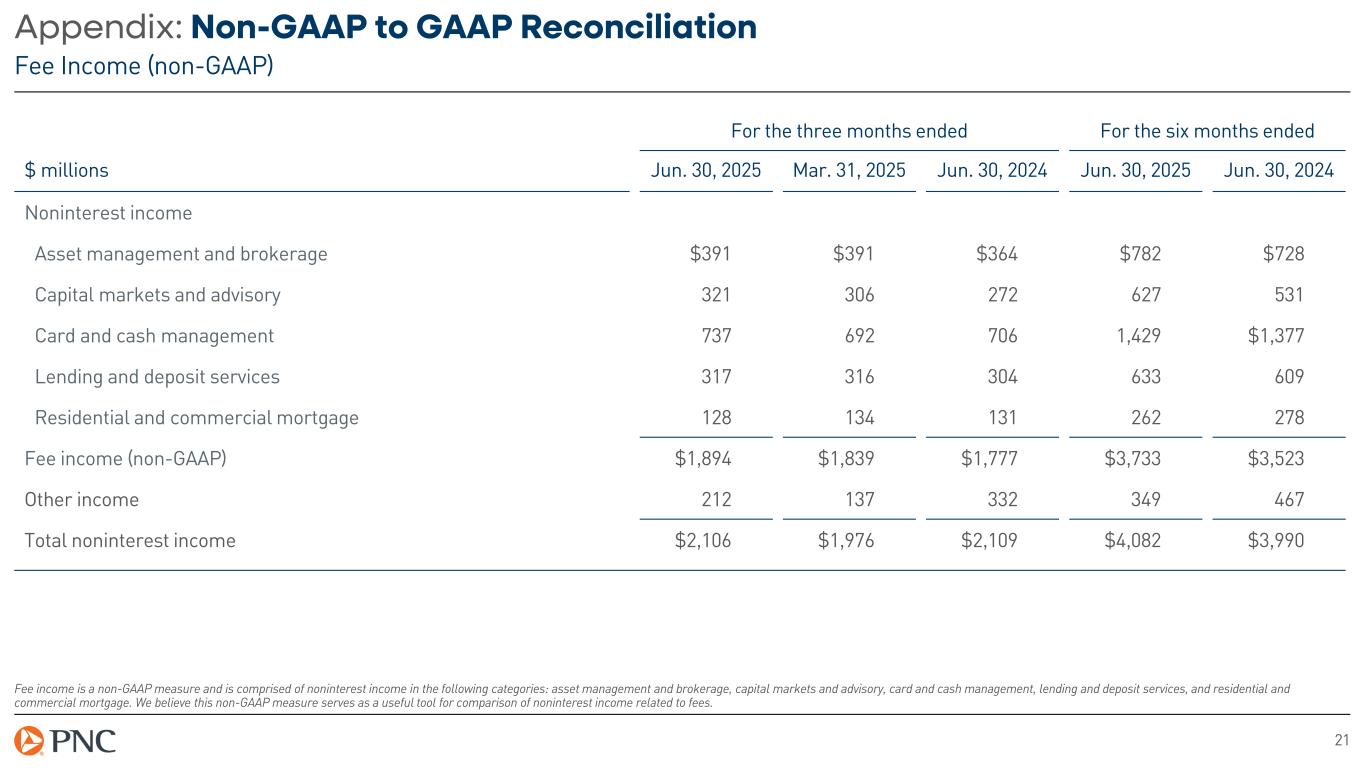
21 Appendix: Non-GAAP to GAAP Reconciliation Fee Income (non-GAAP) For the three months ended For the six months ended $ millions Jun. 30, 2025 Mar. 31, 2025 Jun. 30, 2024 Jun. 30, 2025 Jun. 30, 2024 Noninterest income Asset management and brokerage $391 $391 $364 $782 $728 Capital markets and advisory 321 306 272 627 531 Card and cash management 737 692 706 1,429 $1,377 Lending and deposit services 317 316 304 633 609 Residential and commercial mortgage 128 134 131 262 278 Fee income (non-GAAP) $1,894 $1,839 $1,777 $3,733 $3,523 Other income 212 137 332 349 467 Total noninterest income $2,106 $1,976 $2,109 $4,082 $3,990 Fee income is a non-GAAP measure and is comprised of noninterest income in the following categories: asset management and brokerage, capital markets and advisory, card and cash management, lending and deposit services, and residential and commercial mortgage. We believe this non-GAAP measure serves as a useful tool for comparison of noninterest income related to fees.

22 Appendix: Non-GAAP to GAAP Reconciliation Taxable-Equivalent Net Interest Income (non-GAAP) The interest income earned on certain earning assets is completely or partially exempt from federal income tax. As such, these tax-exempt instruments typically yield lower returns than taxable investments. To provide more meaningful comparisons of net interest income, we use interest income on a taxable-equivalent basis by increasing the interest income earned on tax-exempt assets to make it fully equivalent to interest income earned on taxable investments. This adjustment is not permitted under GAAP. Taxable-equivalent net interest income is only used for calculating net interest margin. Net interest income shown elsewhere in this presentation is GAAP net interest income. For the three months ended For the six months ended $ millions Jun. 30, 2025 Mar. 31, 2025 Jun. 30, 2024 Jun. 30, 2025 Jun. 30, 2024 Net interest income $3,555 $3,476 $3,302 $7,031 $6,566 Taxable-equivalent adjustments 28 28 34 56 68 Taxable-Equivalent Net Interest Income (non-GAAP) $3,583 $3,504 $3,336 $7,087 $6,634
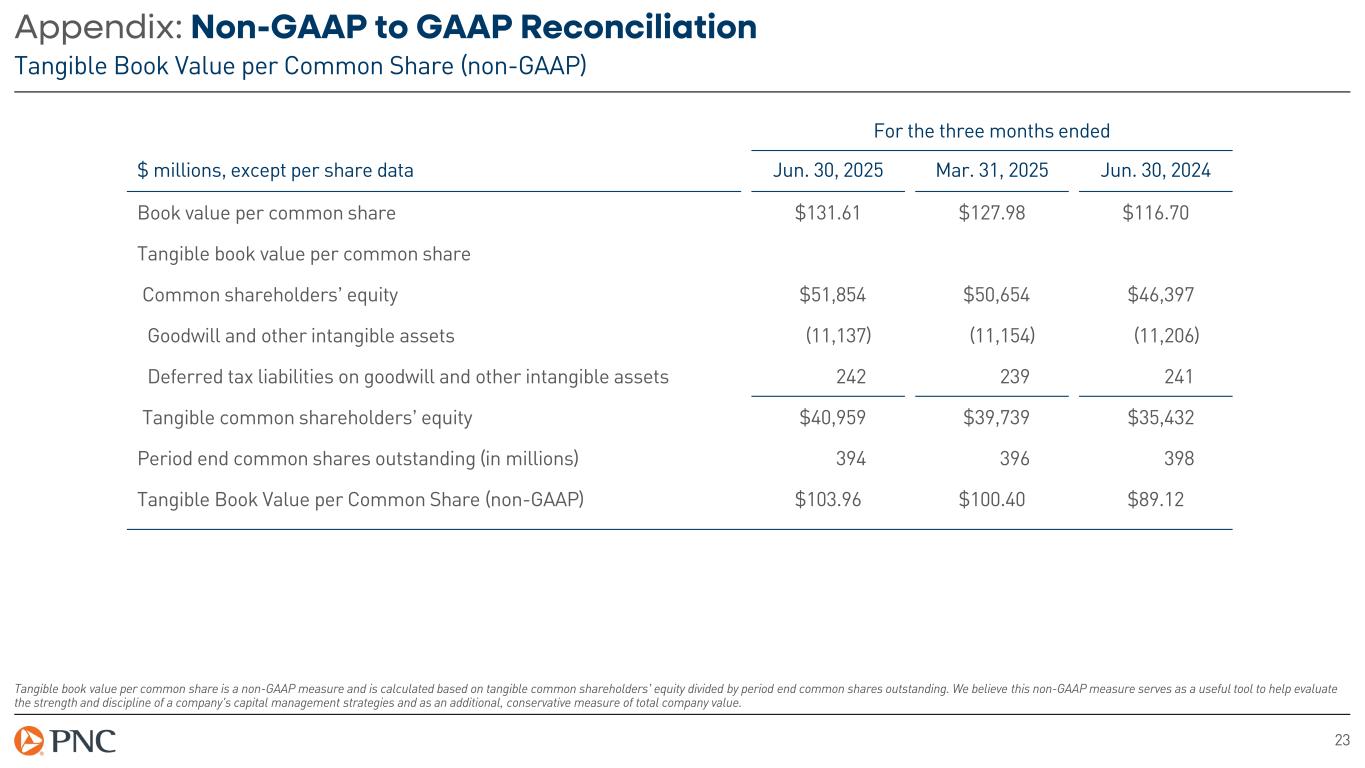
23 Appendix: Non-GAAP to GAAP Reconciliation Tangible Book Value per Common Share (non-GAAP) Tangible book value per common share is a non-GAAP measure and is calculated based on tangible common shareholders’ equity divided by period end common shares outstanding. We believe this non-GAAP measure serves as a useful tool to help evaluate the strength and discipline of a company's capital management strategies and as an additional, conservative measure of total company value. For the three months ended $ millions, except per share data Jun. 30, 2025 Mar. 31, 2025 Jun. 30, 2024 Book value per common share $131.61 $127.98 $116.70 Tangible book value per common share Common shareholders’ equity $51,854 $50,654 $46,397 Goodwill and other intangible assets (11,137) (11,154) (11,206) Deferred tax liabilities on goodwill and other intangible assets 242 239 241 Tangible common shareholders’ equity $40,959 $39,739 $35,432 Period end common shares outstanding (in millions) 394 396 398 Tangible Book Value per Common Share (non-GAAP) $103.96 $100.40 $89.12
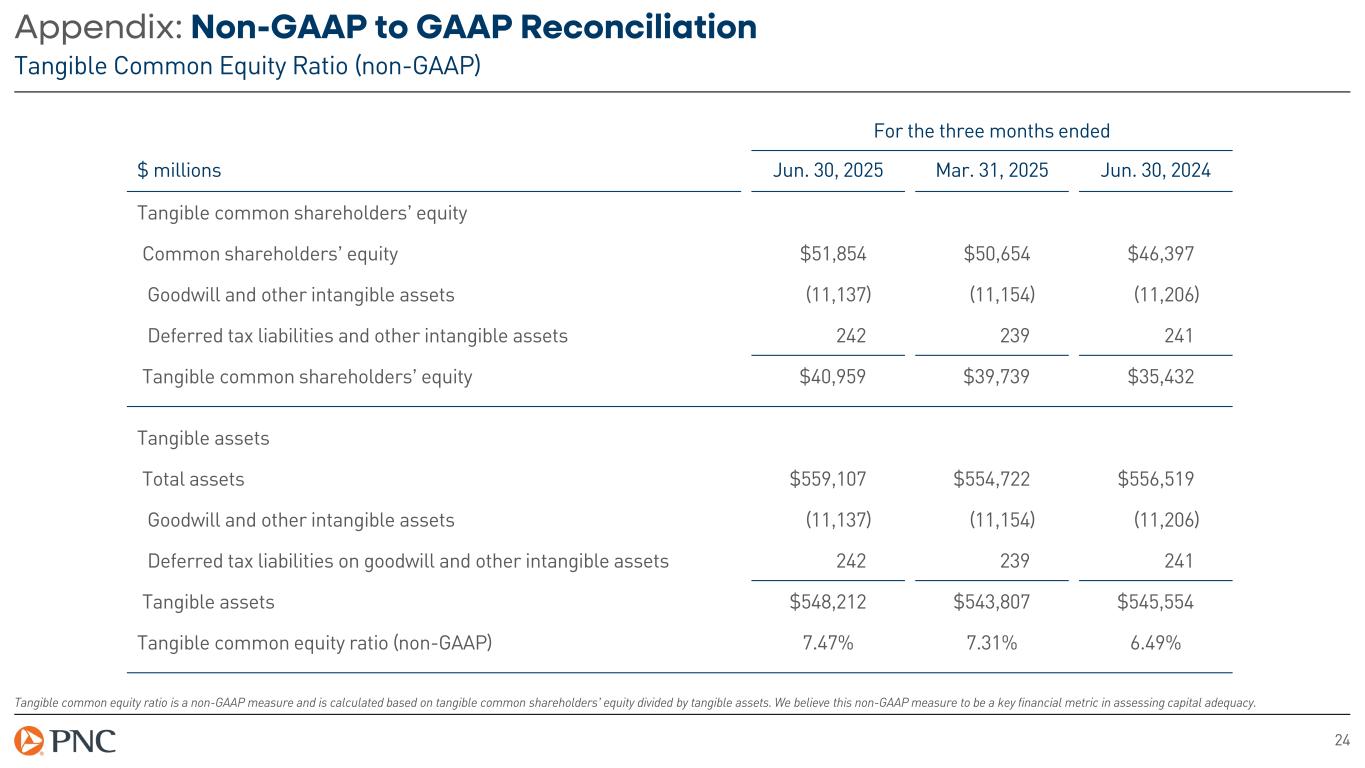
24 Appendix: Non-GAAP to GAAP Reconciliation Tangible Common Equity Ratio (non-GAAP) Tangible common equity ratio is a non-GAAP measure and is calculated based on tangible common shareholders’ equity divided by tangible assets. We believe this non-GAAP measure to be a key financial metric in assessing capital adequacy. For the three months ended $ millions Jun. 30, 2025 Mar. 31, 2025 Jun. 30, 2024 Tangible common shareholders’ equity Common shareholders’ equity $51,854 $50,654 $46,397 Goodwill and other intangible assets (11,137) (11,154) (11,206) Deferred tax liabilities and other intangible assets 242 239 241 Tangible common shareholders’ equity $40,959 $39,739 $35,432 Tangible assets Total assets $559,107 $554,722 $556,519 Goodwill and other intangible assets (11,137) (11,154) (11,206) Deferred tax liabilities on goodwill and other intangible assets 242 239 241 Tangible assets $548,212 $543,807 $545,554 Tangible common equity ratio (non-GAAP) 7.47% 7.31% 6.49%
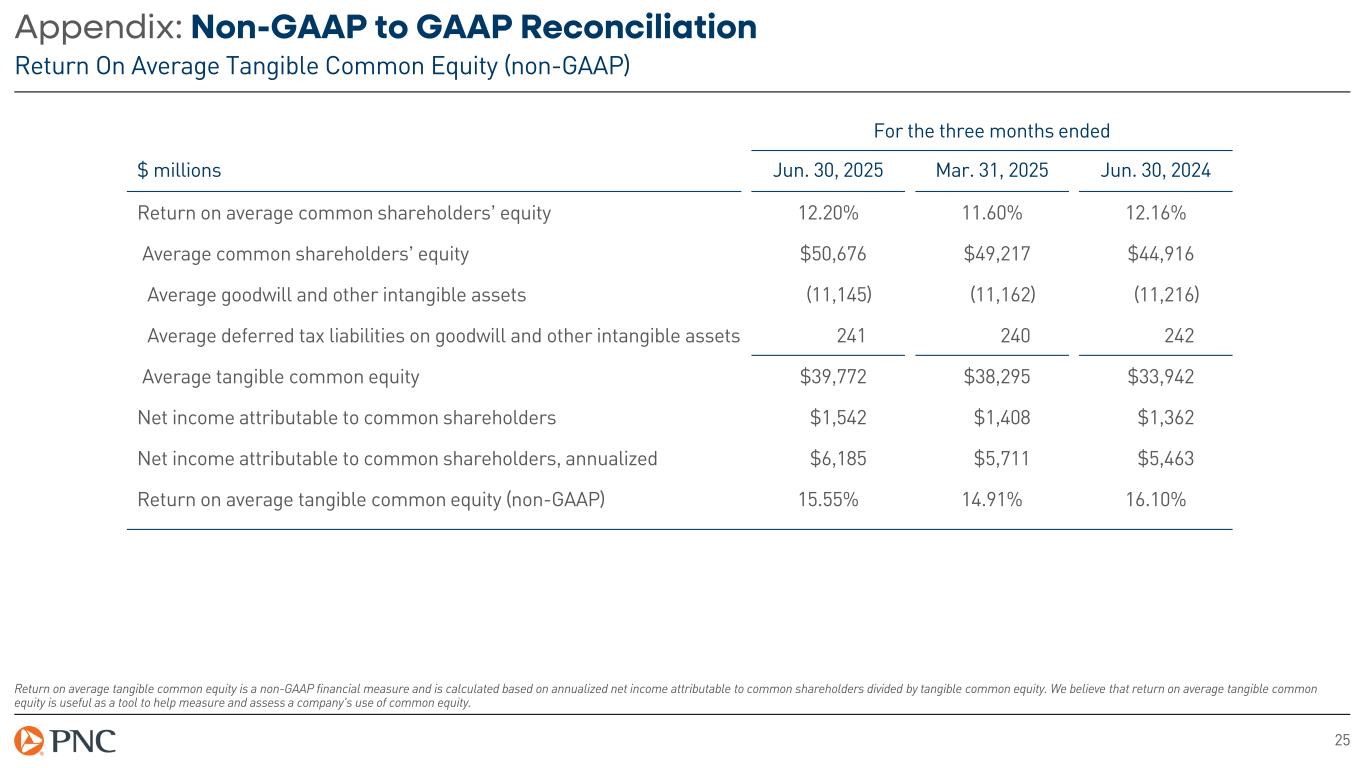
25 Appendix: Non-GAAP to GAAP Reconciliation Return On Average Tangible Common Equity (non-GAAP) Return on average tangible common equity is a non-GAAP financial measure and is calculated based on annualized net income attributable to common shareholders divided by tangible common equity. We believe that return on average tangible common equity is useful as a tool to help measure and assess a company's use of common equity. For the three months ended $ millions Jun. 30, 2025 Mar. 31, 2025 Jun. 30, 2024 Return on average common shareholders’ equity 12.20% 11.60% 12.16% Average common shareholders’ equity $50,676 $49,217 $44,916 Average goodwill and other intangible assets (11,145) (11,162) (11,216) Average deferred tax liabilities on goodwill and other intangible assets 241 240 242 Average tangible common equity $39,772 $38,295 $33,942 Net income attributable to common shareholders $1,542 $1,408 $1,362 Net income attributable to common shareholders, annualized $6,185 $5,711 $5,463 Return on average tangible common equity (non-GAAP) 15.55% 14.91% 16.10%
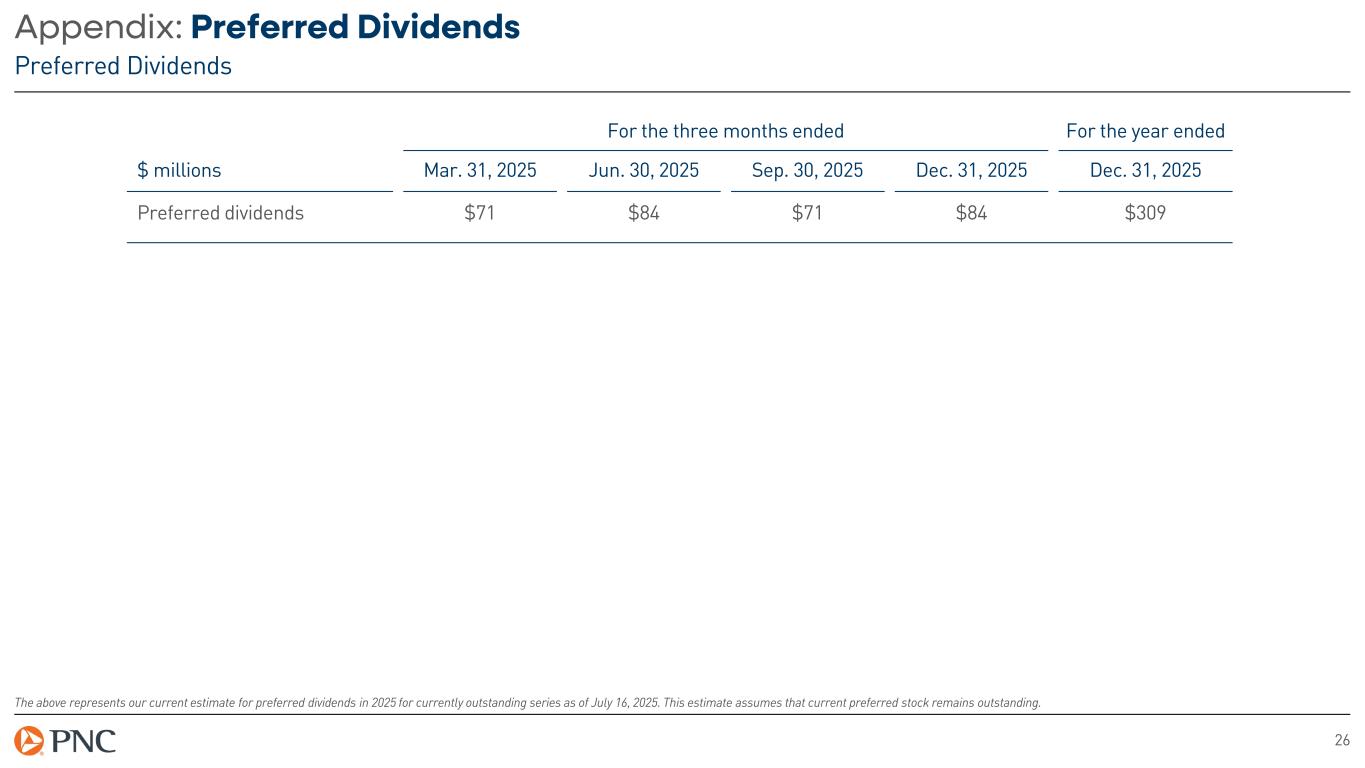
26 Appendix: Preferred Dividends Preferred Dividends The above represents our current estimate for preferred dividends in 2025 for currently outstanding series as of July 16, 2025. This estimate assumes that current preferred stock remains outstanding. For the three months ended For the year ended $ millions Mar. 31, 2025 Jun. 30, 2025 Sep. 30, 2025 Dec. 31, 2025 Dec. 31, 2025 Preferred dividends $71 $84 $71 $84 $309
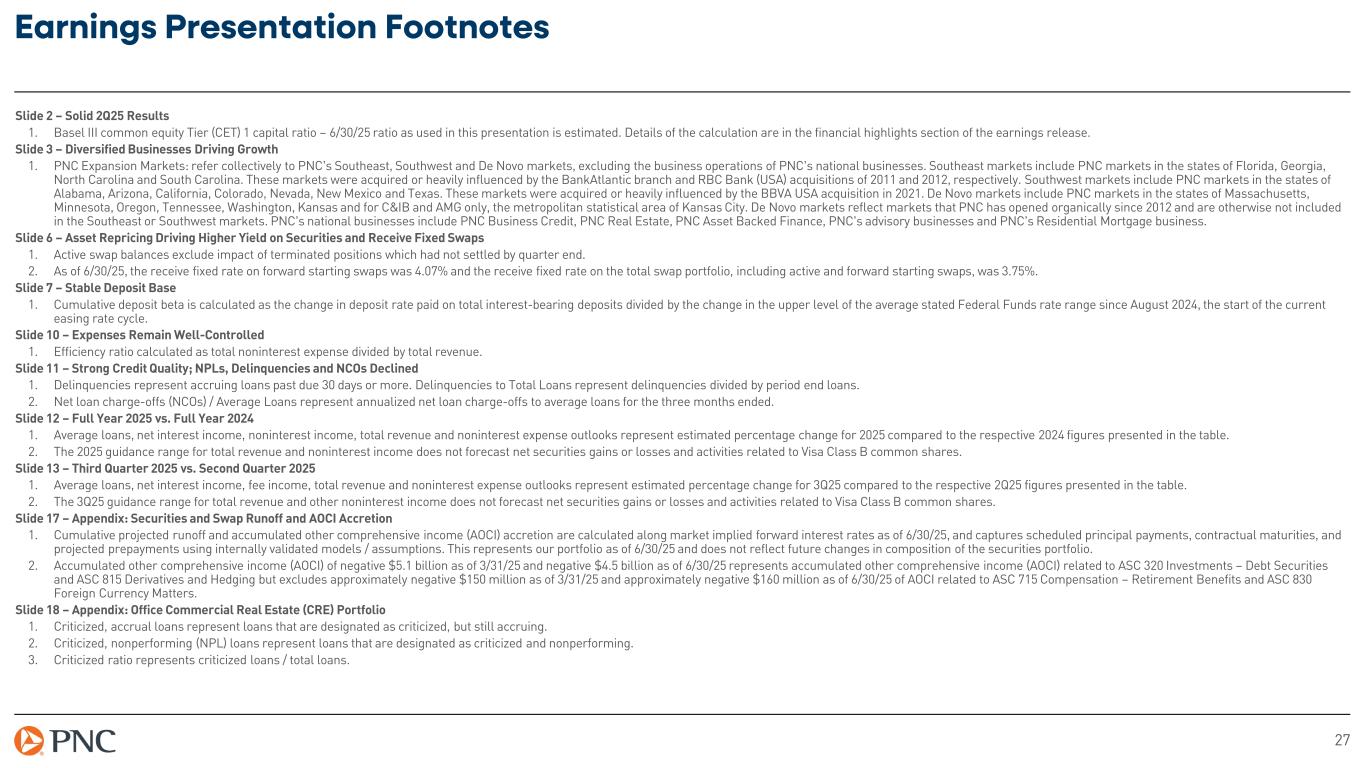
27 Earnings Presentation Footnotes Slide 2 – Solid 2Q25 Results 1. Basel III common equity Tier (CET) 1 capital ratio – 6/30/25 ratio as used in this presentation is estimated. Details of the calculation are in the financial highlights section of the earnings release. Slide 3 – Diversified Businesses Driving Growth 1. PNC Expansion Markets: refer collectively to PNC’s Southeast, Southwest and De Novo markets, excluding the business operations of PNC’s national businesses. Southeast markets include PNC markets in the states of Florida, Georgia, North Carolina and South Carolina. These markets were acquired or heavily influenced by the BankAtlantic branch and RBC Bank (USA) acquisitions of 2011 and 2012, respectively. Southwest markets include PNC markets in the states of Alabama, Arizona, California, Colorado, Nevada, New Mexico and Texas. These markets were acquired or heavily influenced by the BBVA USA acquisition in 2021. De Novo markets include PNC markets in the states of Massachusetts, Minnesota, Oregon, Tennessee, Washington, Kansas and for C&IB and AMG only, the metropolitan statistical area of Kansas City. De Novo markets reflect markets that PNC has opened organically since 2012 and are otherwise not included in the Southeast or Southwest markets. PNC’s national businesses include PNC Business Credit, PNC Real Estate, PNC Asset Backed Finance, PNC’s advisory businesses and PNC’s Residential Mortgage business. Slide 6 – Asset Repricing Driving Higher Yield on Securities and Receive Fixed Swaps 1. Active swap balances exclude impact of terminated positions which had not settled by quarter end. 2. As of 6/30/25, the receive fixed rate on forward starting swaps was 4.07% and the receive fixed rate on the total swap portfolio, including active and forward starting swaps, was 3.75%. Slide 7 – Stable Deposit Base 1. Cumulative deposit beta is calculated as the change in deposit rate paid on total interest-bearing deposits divided by the change in the upper level of the average stated Federal Funds rate range since August 2024, the start of the current easing rate cycle. Slide 10 – Expenses Remain Well-Controlled 1. Efficiency ratio calculated as total noninterest expense divided by total revenue. Slide 11 – Strong Credit Quality; NPLs, Delinquencies and NCOs Declined 1. Delinquencies represent accruing loans past due 30 days or more. Delinquencies to Total Loans represent delinquencies divided by period end loans. 2. Net loan charge-offs (NCOs) / Average Loans represent annualized net loan charge-offs to average loans for the three months ended. Slide 12 – Full Year 2025 vs. Full Year 2024 1. Average loans, net interest income, noninterest income, total revenue and noninterest expense outlooks represent estimated percentage change for 2025 compared to the respective 2024 figures presented in the table. 2. The 2025 guidance range for total revenue and noninterest income does not forecast net securities gains or losses and activities related to Visa Class B common shares. Slide 13 – Third Quarter 2025 vs. Second Quarter 2025 1. Average loans, net interest income, fee income, total revenue and noninterest expense outlooks represent estimated percentage change for 3Q25 compared to the respective 2Q25 figures presented in the table. 2. The 3Q25 guidance range for total revenue and other noninterest income does not forecast net securities gains or losses and activities related to Visa Class B common shares. Slide 17 – Appendix: Securities and Swap Runoff and AOCI Accretion 1. Cumulative projected runoff and accumulated other comprehensive income (AOCI) accretion are calculated along market implied forward interest rates as of 6/30/25, and captures scheduled principal payments, contractual maturities, and projected prepayments using internally validated models / assumptions. This represents our portfolio as of 6/30/25 and does not reflect future changes in composition of the securities portfolio. 2. Accumulated other comprehensive income (AOCI) of negative $5.1 billion as of 3/31/25 and negative $4.5 billion as of 6/30/25 represents accumulated other comprehensive income (AOCI) related to ASC 320 Investments – Debt Securities and ASC 815 Derivatives and Hedging but excludes approximately negative $150 million as of 3/31/25 and approximately negative $160 million as of 6/30/25 of AOCI related to ASC 715 Compensation – Retirement Benefits and ASC 830 Foreign Currency Matters. Slide 18 – Appendix: Office Commercial Real Estate (CRE) Portfolio 1. Criticized, accrual loans represent loans that are designated as criticized, but still accruing. 2. Criticized, nonperforming (NPL) loans represent loans that are designated as criticized and nonperforming. 3. Criticized ratio represents criticized loans / total loans.